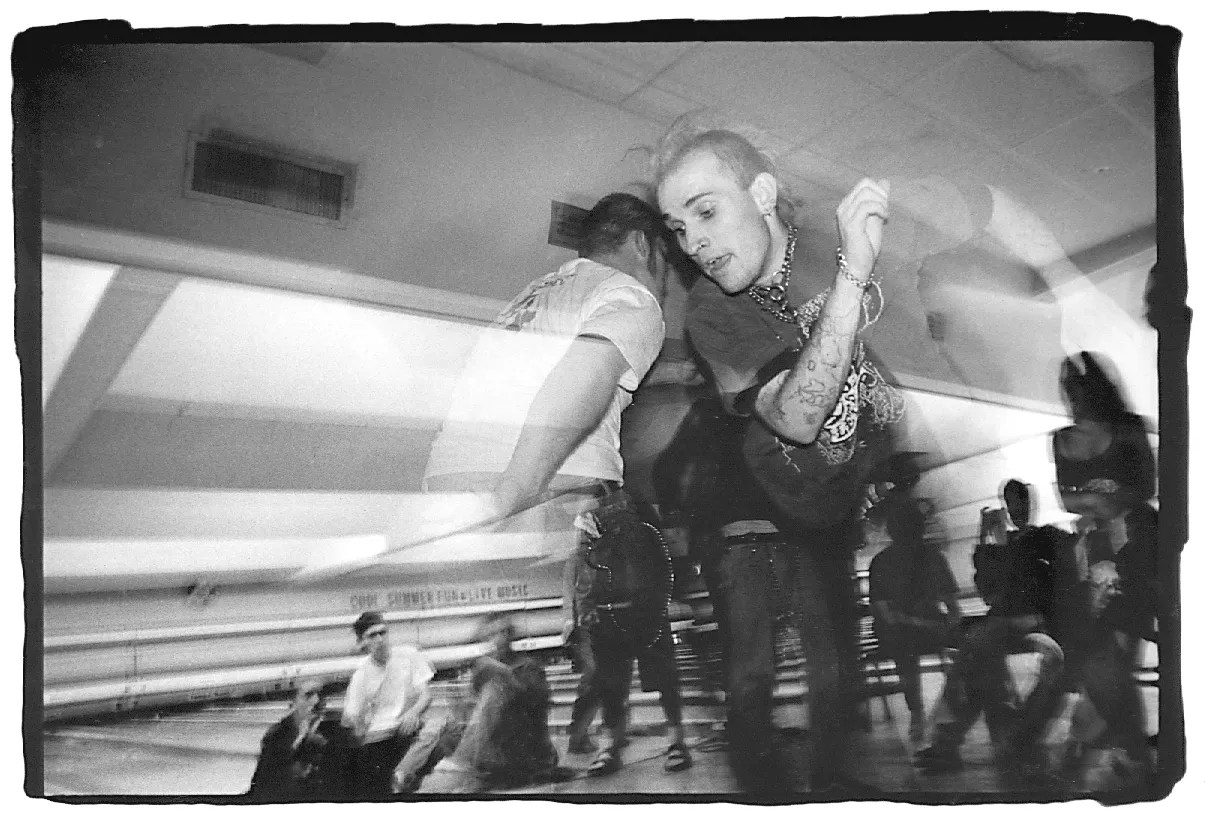
Phoenix New Times archives

Audio By Carbonatix
Despite rumors to the contrary, April 3, 2004, wasn’t the day that the music died in Tempe. It was the date when the plug was pulled on fabled Mill Avenue rock club Long Wong’s, though. The heartbreaking event signaled the end of the city’s biggest live music era, but not a death knell for its scene. Nor were any of the closures that shuttered other prominent Tempe venues in the ensuing years.
The pulse of live music in the east Valley city has ebbed and flowed considerably over the past four decades, from the immense popularity of the Mill Avenue sound around the time that the Gin Blossoms cracked Billboard’s Hot 100 charts with “Hey Jealousy,” to the fallow period following the shuttering of Long Wong’s.
Tempe’s music scene has weathered many ups and downs over the years, including the COVID-19 pandemic, but it will ultimately survive. Will it ever ascend to the height of its ’90s heyday again? Probably not, but that’s not to say it won’t continue to develop new bands and musicians.
As is the norm in any city, venues tend to come and go. Some are felled by progress. Others are victims of the ever-changing whims of patrons or the fickle economy. All these outcomes have taken place in the Tempe scene over the past several decades, proving that the true constant is change.
When news happens, Phoenix New Times is there —
Your support strengthens our coverage.
We’re aiming to raise $30,000 by December 31, so we can continue covering what matters most to you. If New Times matters to you, please take action and contribute today, so when news happens, our reporters can be there.
That’s the spirit behind the following look back at 25 venues that defined live music in Tempe over the last few decades. It illustrates the changes that have occurred in the city’s music scene and also provides a current glimpse at what became of many famed spots.
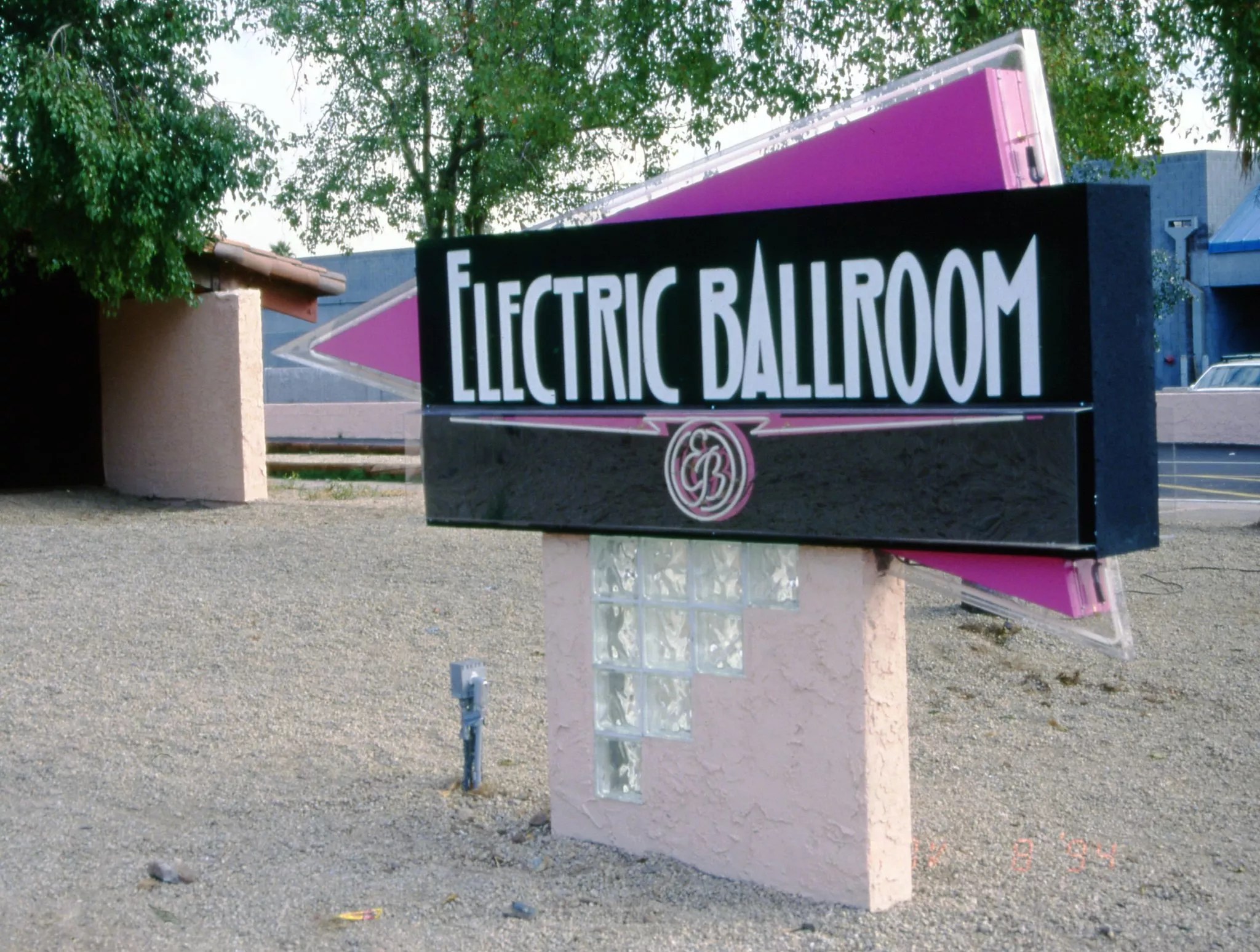
The iconic sign of the Electric Ballroom along Apache Boulevard.
Tempe History Museum
Dooley’s/After the Gold Rush/Electric Ballroom
1216 E. Apache Blvd., Tempe
Currently: New School for the Arts & AcademicsLong before its current status as an arts charter school, this uniquely shaped structure served as a series of music venues featuring a “who’s who” of the music world. In the ’70s and into the ’80s, the 700-person establishment was called Dooley’s and had gigs by the likes of Devo, Tom Petty, Elvis Costello, The Kinks and Blondie.
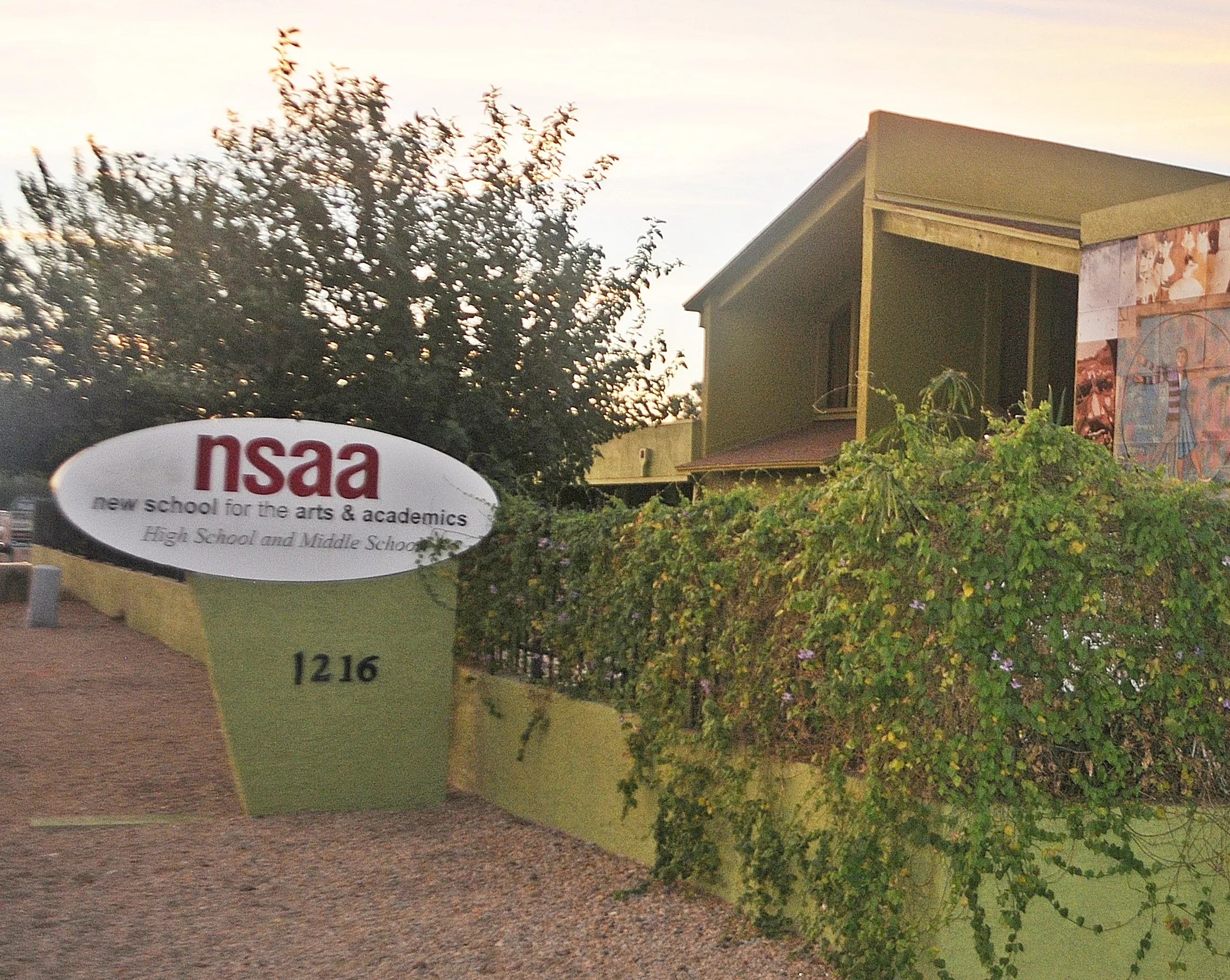
New School for the Arts & Academics in Tempe, formerly Electric Ballroom.
Benjamin Leatherman
Many of these shows were booked by local promoter Danny Zelisko, as he spent his embryonic years in the concert business bringing in acts to the venue shortly after launching his now-defunct Evening Star Productions in the mid-1970s. He continued bringing in shows after the venue changed owners and names twice over the following two decades, becoming After the Gold Rush in the early ’80s and the Electric Ballroom in the early ’90s.
Each hosted notable acts. After the Gold Rush, for example, bridged the heyday of hard rock and hair metal (Cinderella, King’s X, Faster Pussycat) into the rise of grunge and alternative (Nirvana, Mr. Bungle, Widespread Panic). Electric Ballroom had a wide variety of gigs, running the gamut from The Cramps, L7 and Social Distortion to Bloodhound Gang and Blur.
The property’s concert history ended in the late ’90s, due in part to an alleged sexual assault by the rappers of Onyx. (The incident led to the liquor license getting pulled by state officials.) The New School for the Arts & Academics purchased the property in the early 2000s.

The sign for Boston’s in 1991.
Tempe History Museum
Boston’s
910 N. McClintock Drive, Tempe Boston’s became now-defunct strip club Elite Cabaret. Benjamin Leatherman
Currently vacantDescribed by former Phoenix New Times scribes as an “East Valley rock mecca,” Boston’s was a shabby dive with plenty of verve. It was owned by Al Nichols, who ran the place with his three sons, Corey, Keith and Jeff. Shows took place on both its indoor and outdoor stages and included numerous local and touring bands.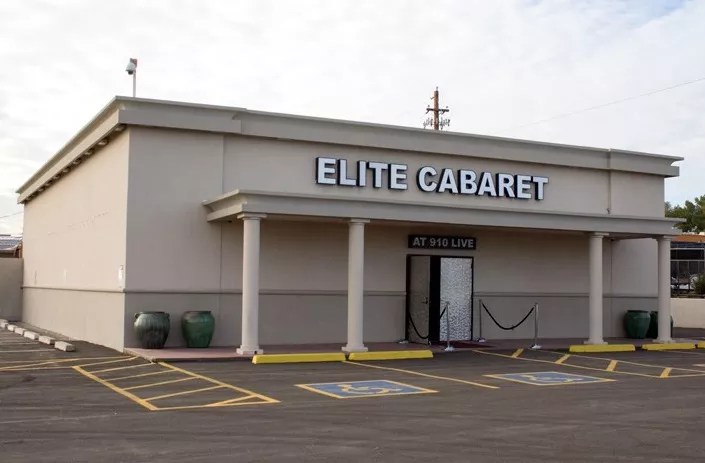
The well-remembered Tempe bar, which operated from 1991 until 2002 and was a hub for rock, punk, alternative, metal, ska and indie. Search the web and you’ll see an enviable list of touring acts that hit up Boston’s during its run, including The Specials, Napalm Death, Jesus Lizard, Rocket From the Crypt, Flogging Molly, Weezer, Slipknot, Mike Ness and Jello Biafra.
Following Boston’s closure, it became a Latin dance spot called Club Macarena for a bit, only to eventually go vacant again. In 2009, it reopened as 910 Live, a combination nightclub/venue that mixed live music with DJs, including a notable gig by a pre-breakthrough Skrillex in 2011. By 2013, the main room was transformed into a now-defunct gentleman’s club known as Elite Cabaret.
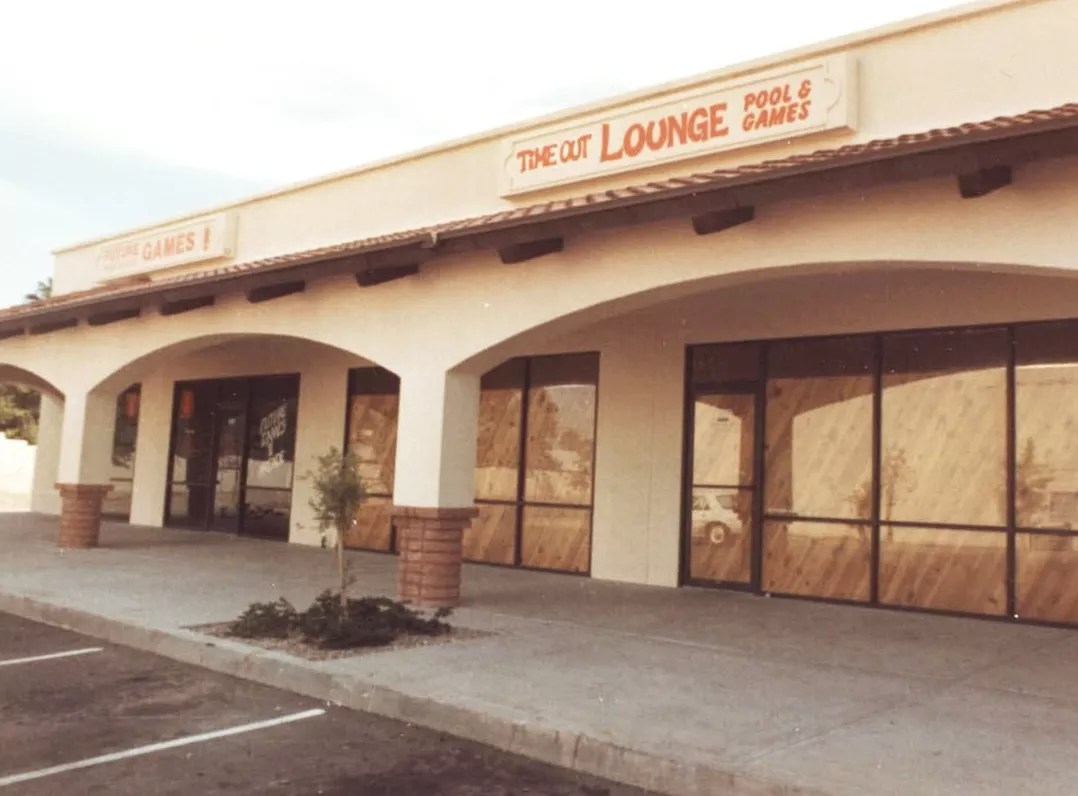
Time Out Lounge in 1982,
Tempe History Museum
Time Out Lounge
3129 S. Mill Ave., Tempe Gin Blossoms play the Hayden Square Amphitheater during the 1990s. Tempe History Museum
Currently still operating Nestled in Tempe’s Huntington Square Shopping Center near Southern and Mill avenues, Time Out Lounge has offered the quintessential comforts of a neighborhood bar – including darts, billiards and booze – since 1982. Current owners Laura Kelly-Phillips and husband Ed, who purchased the spot in 1988, kept the place relatively the same over the decades, including its laidback vibe. After a 2007 statewide public smoking ban snuffed out lighting up in bars, Kelly-Phillips began booking rock, punk and metal shows, as well as occasion DJ nights and acoustic sessions. Since then, Time Out Lounge has evolved into a cherished spot for local musicians and their fans, hopefully poised to maintain its popularity for decades to come.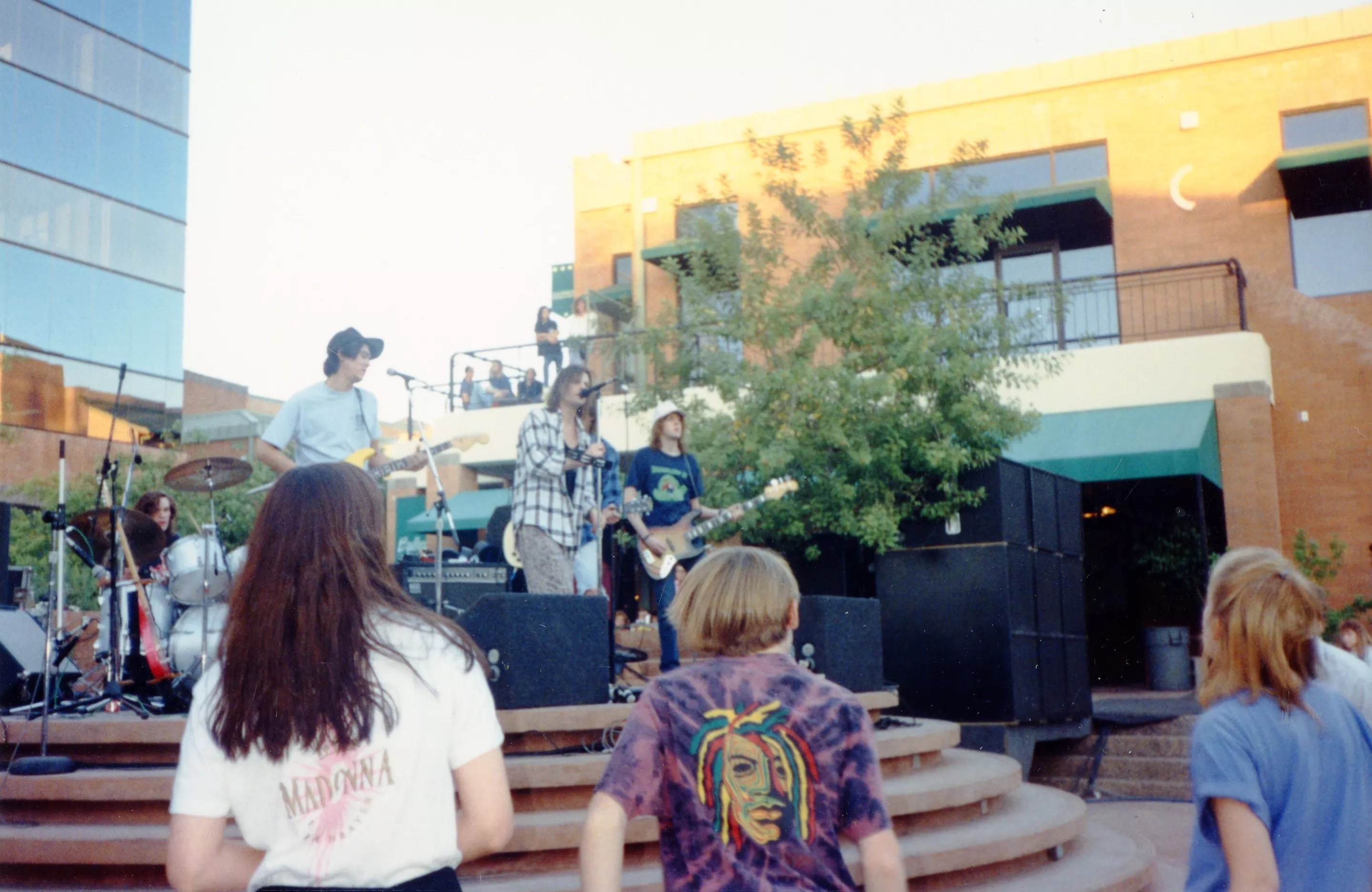
Hayden Square Amphitheater
404 S. Mill Ave., Tempe
Currently still operating Back in the ’90s, Hayden Square in downtown Tempe boasted a small nexus of venues sharing a symbiotic relationship and groove with the Mill Avenue scene. Situated around a Fourth Street cul-de-sac, its cluster of now-defunct bars was a stomping grounds for musicians, including Balboa Cafe, Chuy’s, and Edcels Attic.
At the center of Hayden Square was a modest outdoor amphitheater. Performances were common throughout the 1990s by alternative bands (Soul Asylum, Garbage, They Might Be Giants) and hard rock acts (Stabbing Westward, Deftones). Phish also put on a memorable gig in 1994 attended by thousands.
These days, the area is referred to as “Hayden Station” (because of its proximity to a light-rail stop) and is still used for occasional gigs, like when the Gin Blossoms returned to their roots and played during 2014’s Tempe New Year’s Eve Block Party. In 2019, it hosted the Hay Day Music Festival with sets by Roger Clyne and the Peacemakers, The Pistoleros, Wise Monkey Orchestra and The Hourglass Cats.
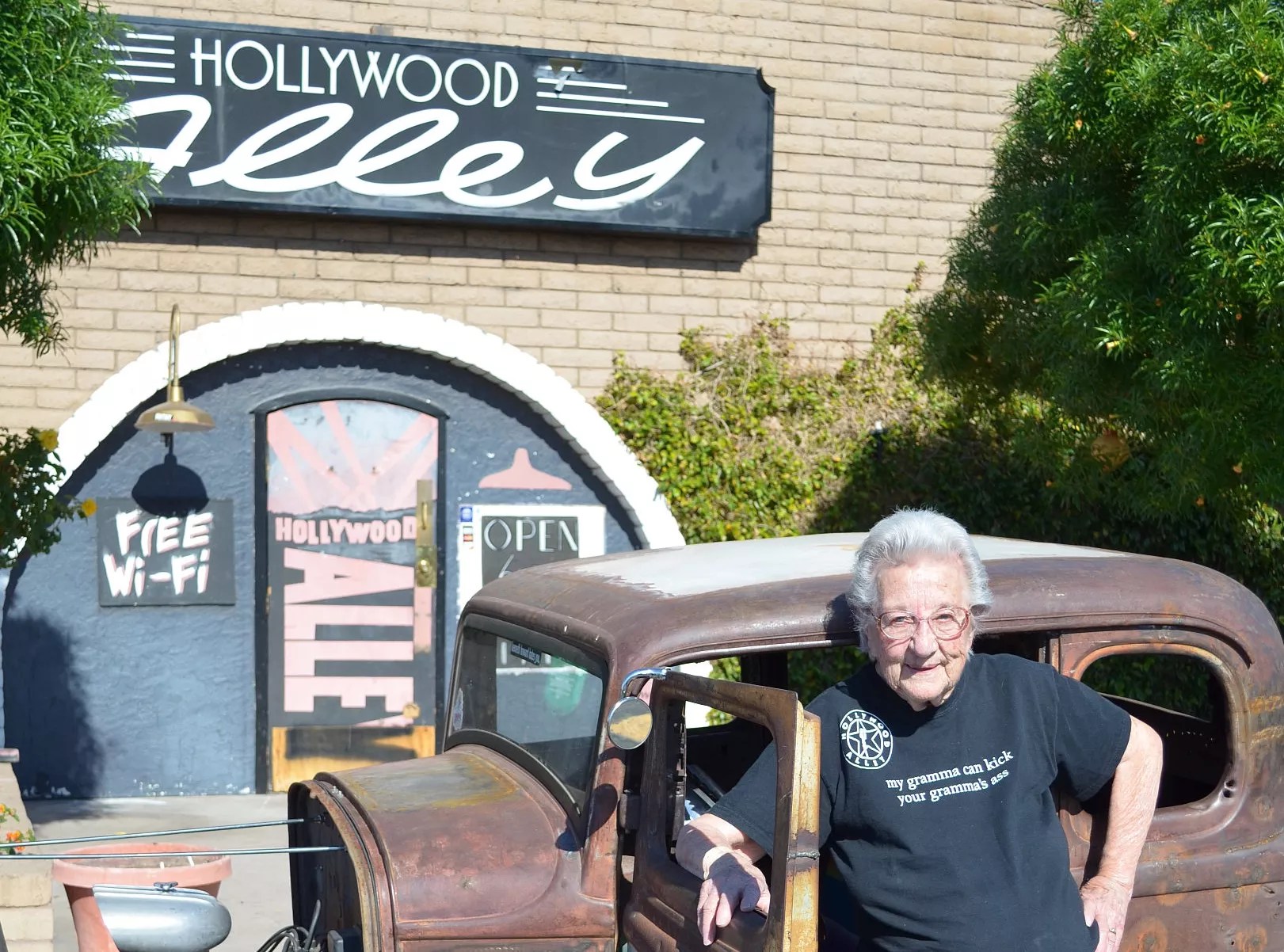
The late Rachel Hrutkay in front of Hollywood Alley, the rock bar owned by her family that operated from 1988 to 2013.
Tempe History Museum
Hollywood Alley
2610 W. Baseline Road, Mesa
Currently: Punch Kick Fit For 25 years, this “ultra-chic pissant hip dive bar” located on the border of Tempe and run by the Wincek family was a much-beloved bar, restaurant, music venue, arcade and second home to many drinkers and Valley musicians.
Within its well-worn walls – which were famously covered with peeling movie posters, old LPs and other ephemera – an impressive variety of talents both local and touring performed for the delight of crowds both large and small. Another draw was the lineup of homemade recipes created by Rachel Hrutkay, the grandmother of the Wincek family.
Hollywood Alley closed in 2013 because of financial issues faced by the Winceks. Shortly after its shuttering, it was stripped of every single bit of memorabilia by its proprietors and regulars and was completely remodeled by the property owners. After operating as a secondhand store for years, it’s now a local boxing gym Punch Kick Fit.
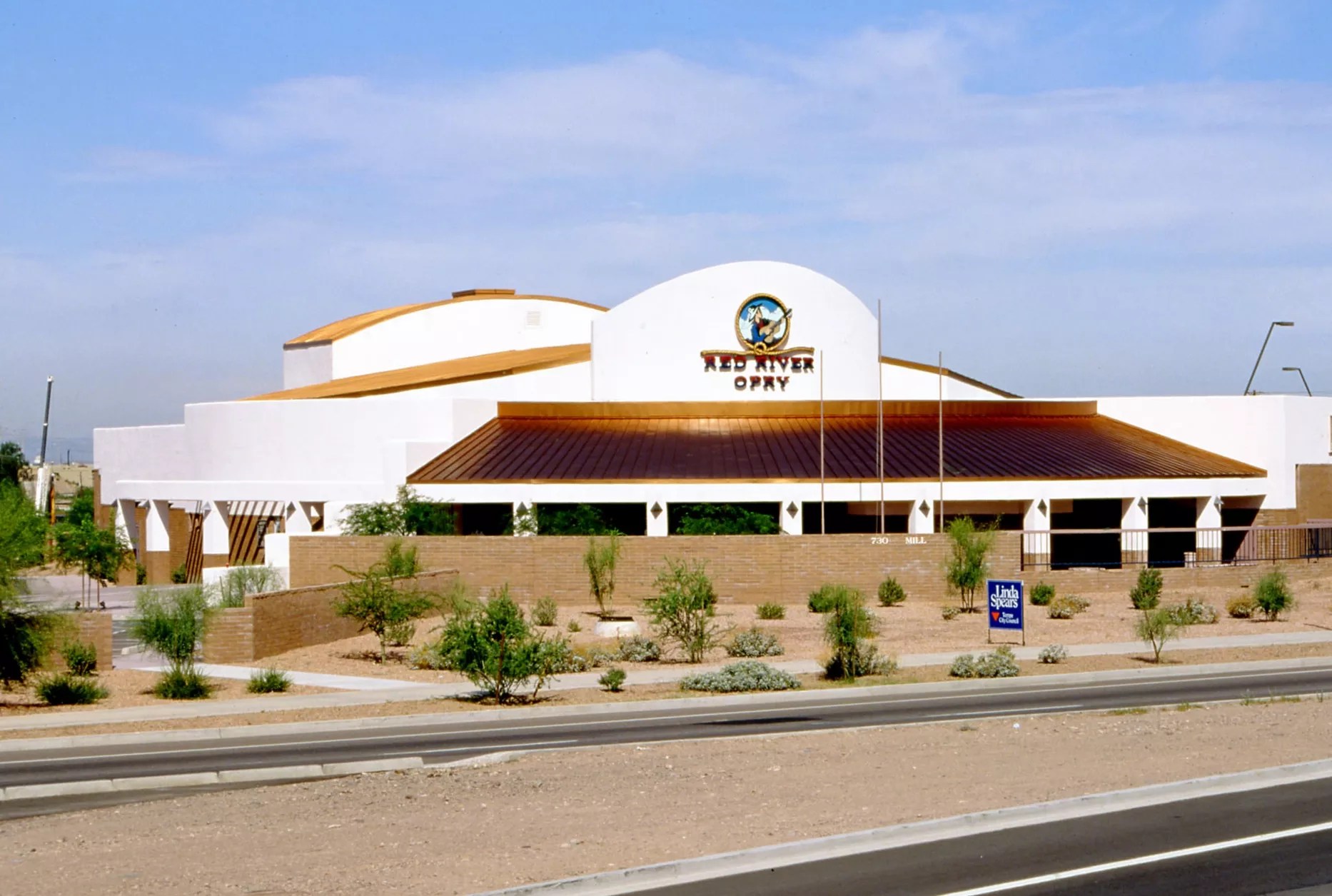
A 1994 photo of the Red River Opry, which became the Marquee Theatre.
Tempe History Museum
Red River Opry
730 N. Mill Ave., Tempe
Currently: Marquee Theatre A decade before Marquee Theatre opened for business in March 2003 at the corner of Mill Avenue and Washington Street, the expansive building was the domain of country crooners and down-home sounds. In 1993, the venue debuted as the Red River Opry, a family-oriented place with auditorium seating and a theatrical-style revue called the “Arizona’s Country Music Show.”
At the time, New Times writers described the performances as a “scripted blend of family-friendly crossover country and pop, punctuated with a bit of comedy.” Yee-haw. Long after the Red River Opry headed for the last roundup, the property became the concert hall we all know today, sans the seating and all the heaping helpings of cornpone. Since becoming the Marquee, it’s put on more than 2,000 concerts.
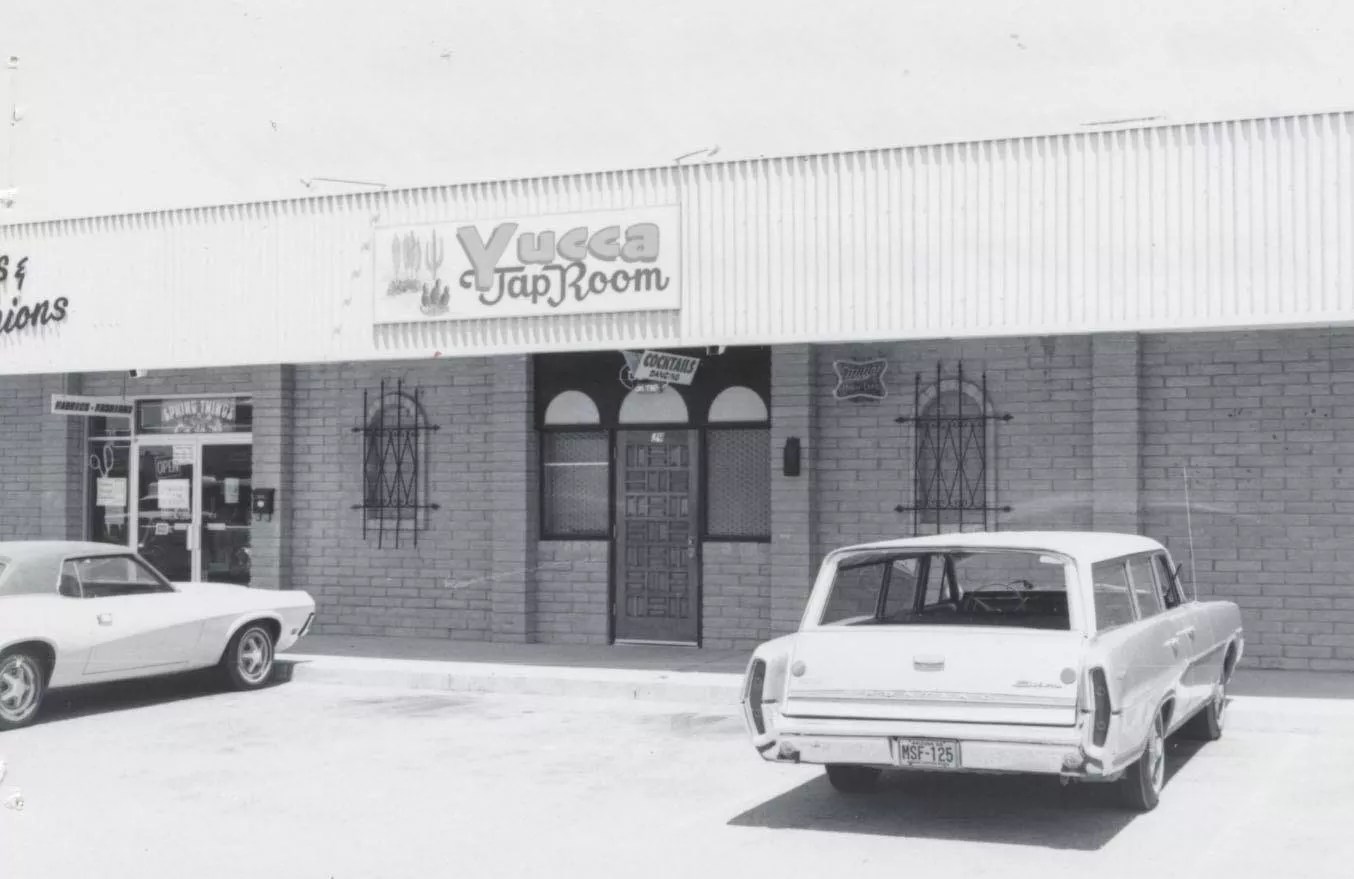
Yucca Tap Room in the 1970s.
Tempe History Museum
Yucca Tap Room
29 W. Southern Ave., Tempe
Currently still operating
Yucca Tap is a survivor. It’s withstood economic downturns, evolving tastes and even the pandemic. It’s largely because the bar and venue, which has been owned by the Hu family since the early ’70s, has changed with the times. A 2009 expansion added a craft beer/whiskey bar and kitchen while an adjacent arcade came along in 2018. Meanwhile, the main room at the Yucca has remained largely the same, right down to its wood-paneled walls. And if they could talk, they’d spin tales of the countless gigs that have happened here.
After featuring a few different house bands on weekends, the Hu family started presenting local live music in 1989, including many of the famed acts that put Tempe on the map. Current owner Rodney Hu can rattle off a rundown of some of the more well-remembered bands that played at the Yucca, such as Flathead, Spinning Jennies, The Pistoleros, Satellite and The Refreshments. And as new groups were born, the bar offered up its stage to each, ranging from Grave Danger and The Black Moods to The Format (who performed a memorable acoustic set in 2005).
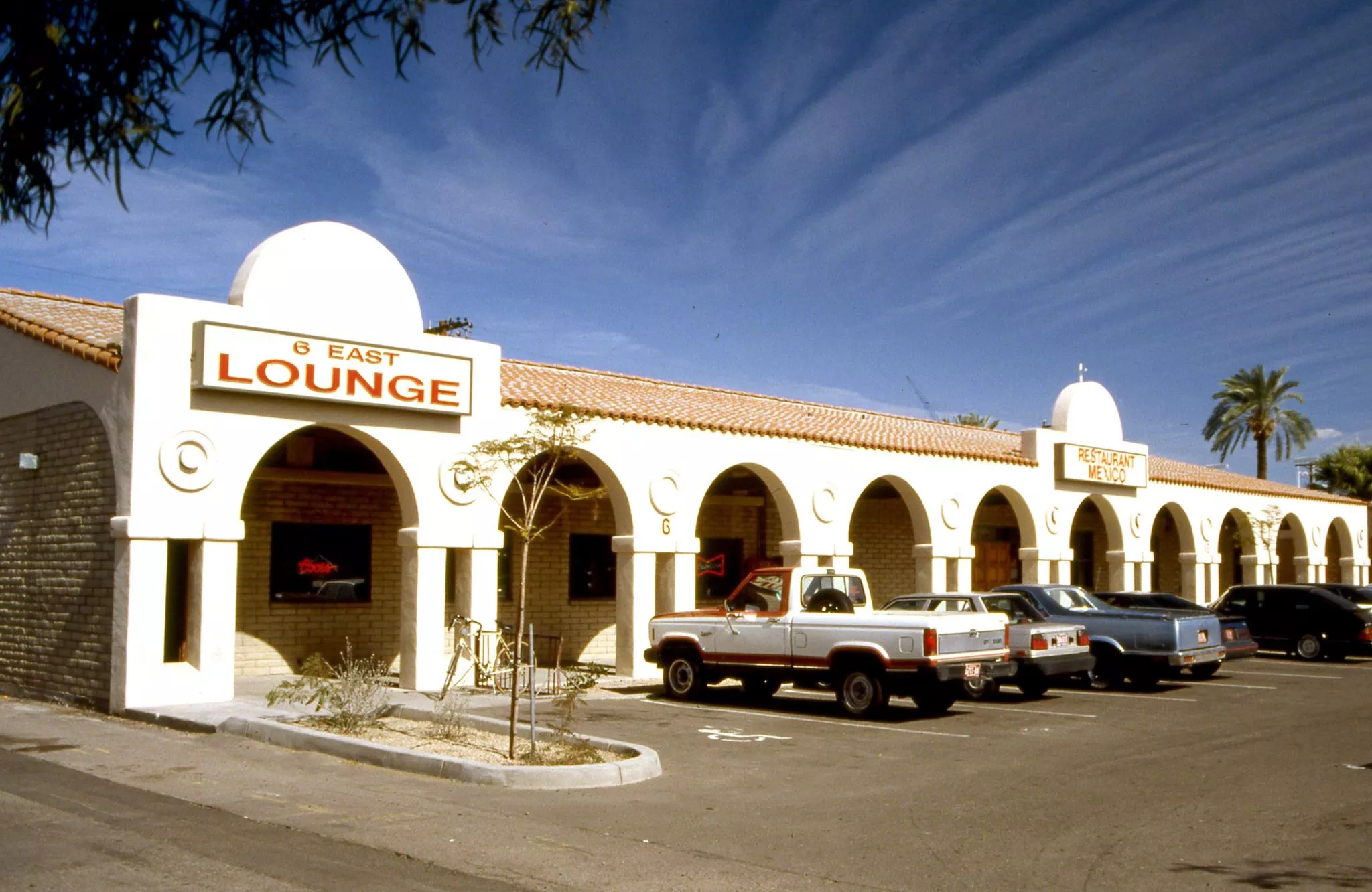
A photo of 6 East Lounge from 1998.
Tempe History Museum
6 East Lounge
6 E. Seventh St., Tempe
Currently: ASU Art Museum Brickyard Old-school Tempe haunts don’t get more notorious than the 6 East Lounge, a much-beloved shithole dive that was spitting distance from Mill Avenue. Fondly known as “The Beast,” the joint was a sight to behold – a putrid, pungent mess with bullet holes riddling the walls, graffiti carved into tabletops and an aroma of rancid urine and stale booze mixed with the scent of cleaning chemicals. To paraphrase former New Times contributor David Holthouse, 6 East was not for the squeamish.
A relic from downtown Tempe’s past, 6 East debuted in 1973. Shifting into a biker bar by the early ’80s, it later became a hotspot for musicians from Mill Avenue’s rock scene in the ’90s. These artists frequented the joint before and after their gigs at Long Wong’s and nearby venues. Their fans and others in the Tempe scene soon followed, leading to a diverse crowd of what Holthouse described as “skaters, punks, rockabilly enthusiasts, tweakers, junkies and straight-up Gen X barflies” hanging out at “The Beast” on the regular.
Like other spots on this list, redevelopment felled the 6 East in 1998, as it was eventually razed to make way for the Brickyard on Mill. The boozy soul of the establishment lives on at Tempe’s Cornish Pasty Co., which named its side room bar The Beast in honor of the lounge.
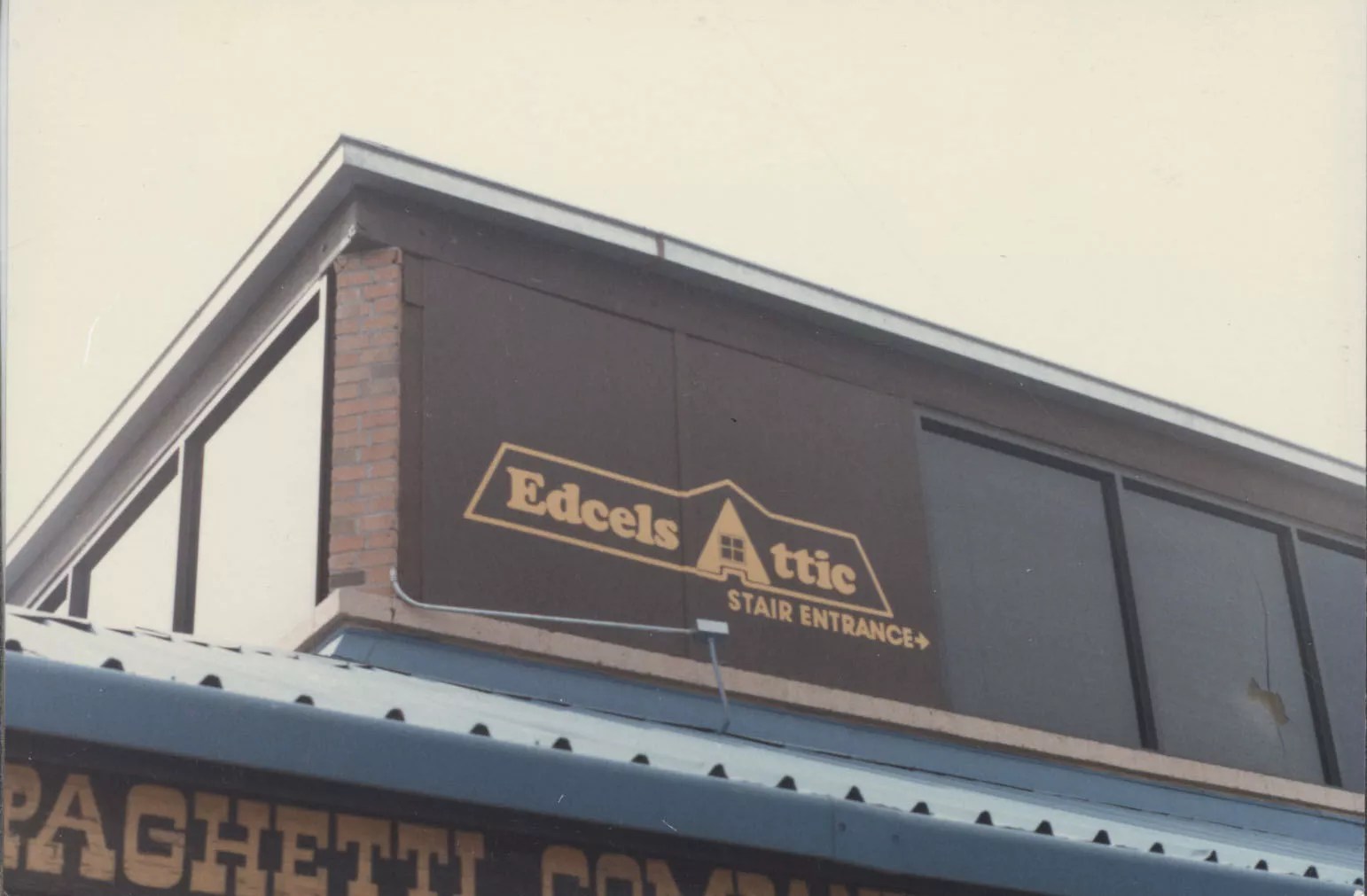
Edcels Attic in a 1986 photo.
Tempe History Museum
Edcels Attic
414 S. Mill Ave., Tempe
Currently: GLOW Shots & CocktailsNeed proof of the ever-evolving state of Tempe’s nightlife scene? Look no farther than this second-floor spot, which has previously been known as The Upstairs Pub, Ziggy’s, Vintage Bar & Grill, the Coconut Club, PA Connection and the BAC Lounge over the years. Its longest stint was as Edcels Attic (or Edsels Attic, depending on the source) during the decade-long stretch from the mid-’80s to the mid-’90s.
Live music was on tap nightly from a rotating selection of bands, running the gamut from the blues-oriented Chuck Hall and the Brick Wall to the Bruce Connole-led alternative ensemble The Strand. Longtime owners Ed Chiongbian and Cely Bossany, who purchased the place in 1986, also frequently booked artists like Walt Richardson and Morningstar, the Zubia brothers and Brides of Science.
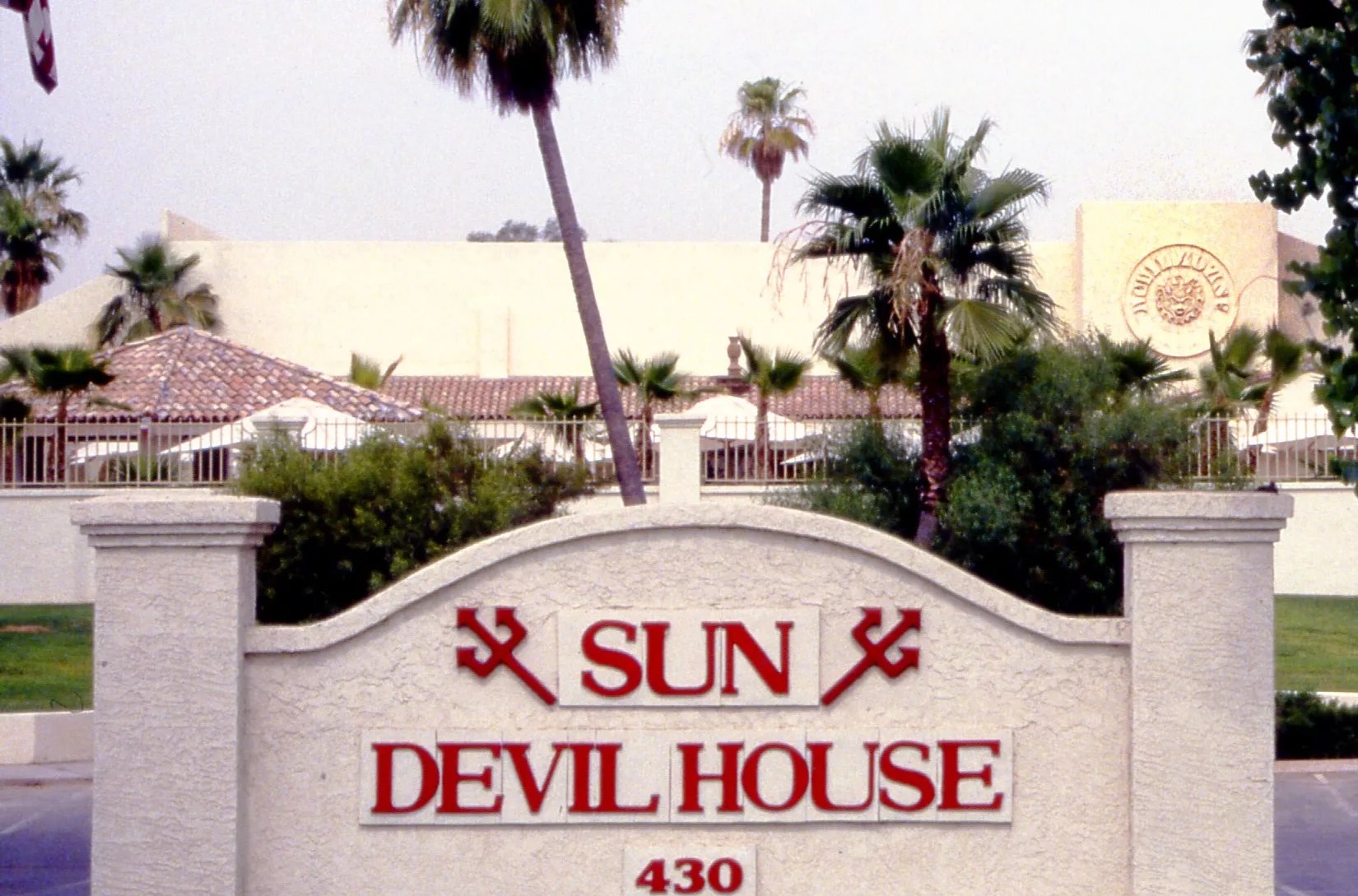
Devil House eventually became Club Rio.
Tempe History Museum
Devil House/Club Rio
430 N. Scottsdale Road, Tempe Multimillion-dollar development The Watermark. Google Maps
Currently: The Watermark TempeThroughout the ’80s and ’90s, this spot along Scottsdale Road just north of the Salt River was a major rage haven for ASU kids and 20-somethings. It debuted in 1981 as the Devil House, and later became Club Rio, offering a mix of theme events (like its Saturday foam parties) and DJ nights throughout its 23-year lifespan. 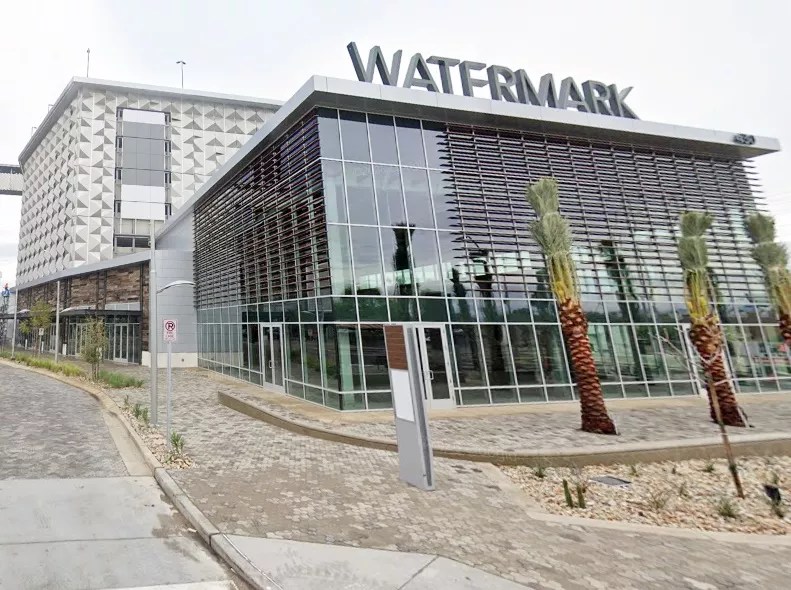
Club Rio’s party-hardy infamy was due in no small part to its cheap and plentiful drinks, which led to both good times and bad decisions during its run. (Onetime Arizona Cardinals quarterback Jake Plummer got in trouble back in 1997 for allegedly fondling four women inside the club.)
Besides serving as a notorious nightspot, Club Rio was a popular concert venue, especially during the 1990s and into the new millennium. Countless acts from that era gigged at Club Rio, including Bad Religion, Porno for Pyros, Green Day, Jesus Jones, Ben Folds Five, Korn, System of a Down and Soulfly.
After later becoming the Arizona Beach Club for a spell, the club was torn down in the mid-2000s, and the property is now The Watermark Tempe, a $150 million mixed-use development.
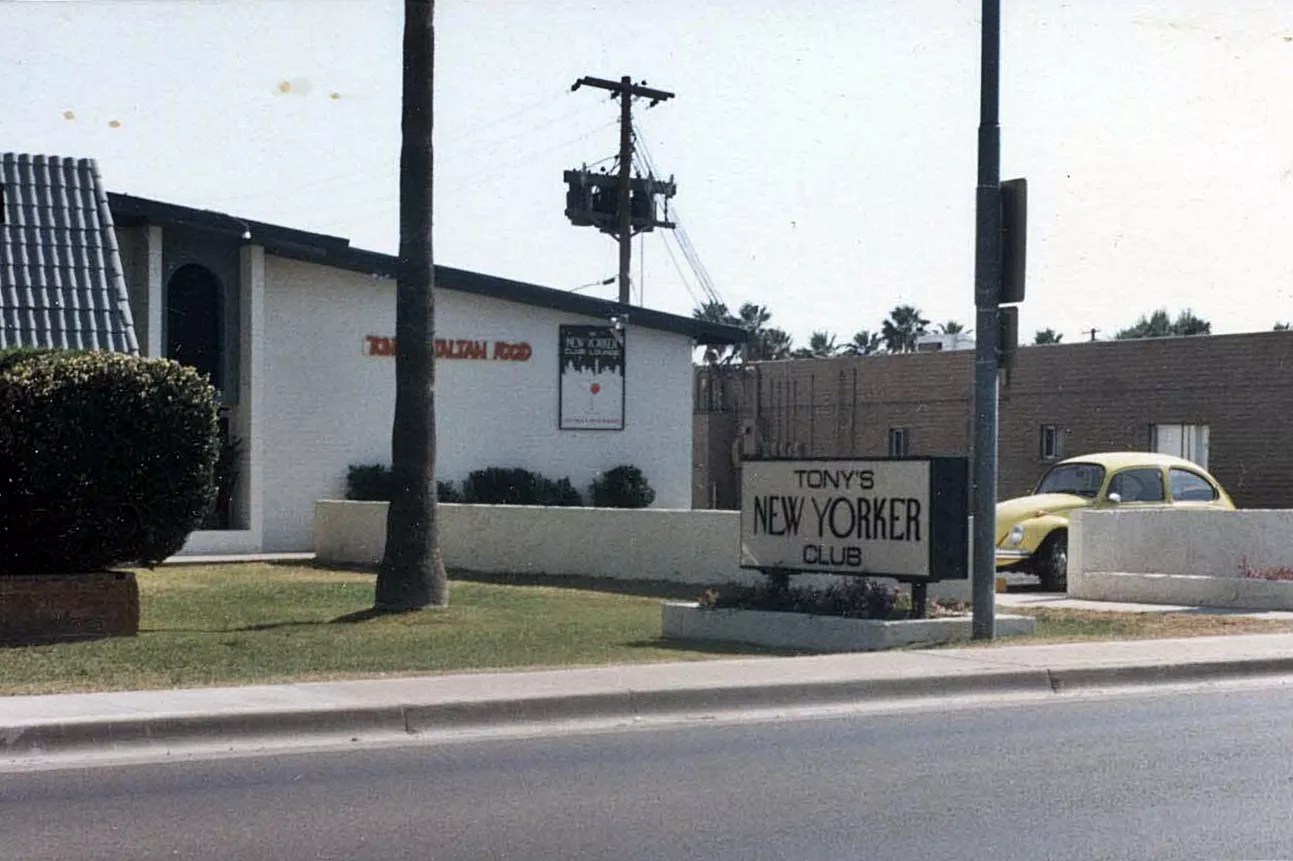
Tony’s New Yorker on Broadway Road featured blues, rock and more.
Tempe History Museum
Tony’s New Yorker
107 E. Broadway Road, Tempe
Currently: American Legion Post 138This property along Broadway Road just off Mill Avenue started out as a church, then became a nightclub before a noteworthy stint in the late ’80s and most of the ’90s as Tony’s New Yorker.
The Italian restaurant and its attached lounge were graced by many legendary Tempe musicians, including bands like the Piersons, bluesman Hans Olson and the late Doug Hopkins. In fact, the troubled Gin Blossoms songwriter and guitarist reportedly played his final gig at Tony’s alongside Olson in late 1993 shortly before taking his own life.
These days, music still echoes through the building, as it’s now an American Legion Post 138. Artists and bands occasionally perform inside the large and lively bar, which is a favorite of neighborhood folk, former servicemen and a variety of biker types. Like with any American Legion Post, however, membership is required.
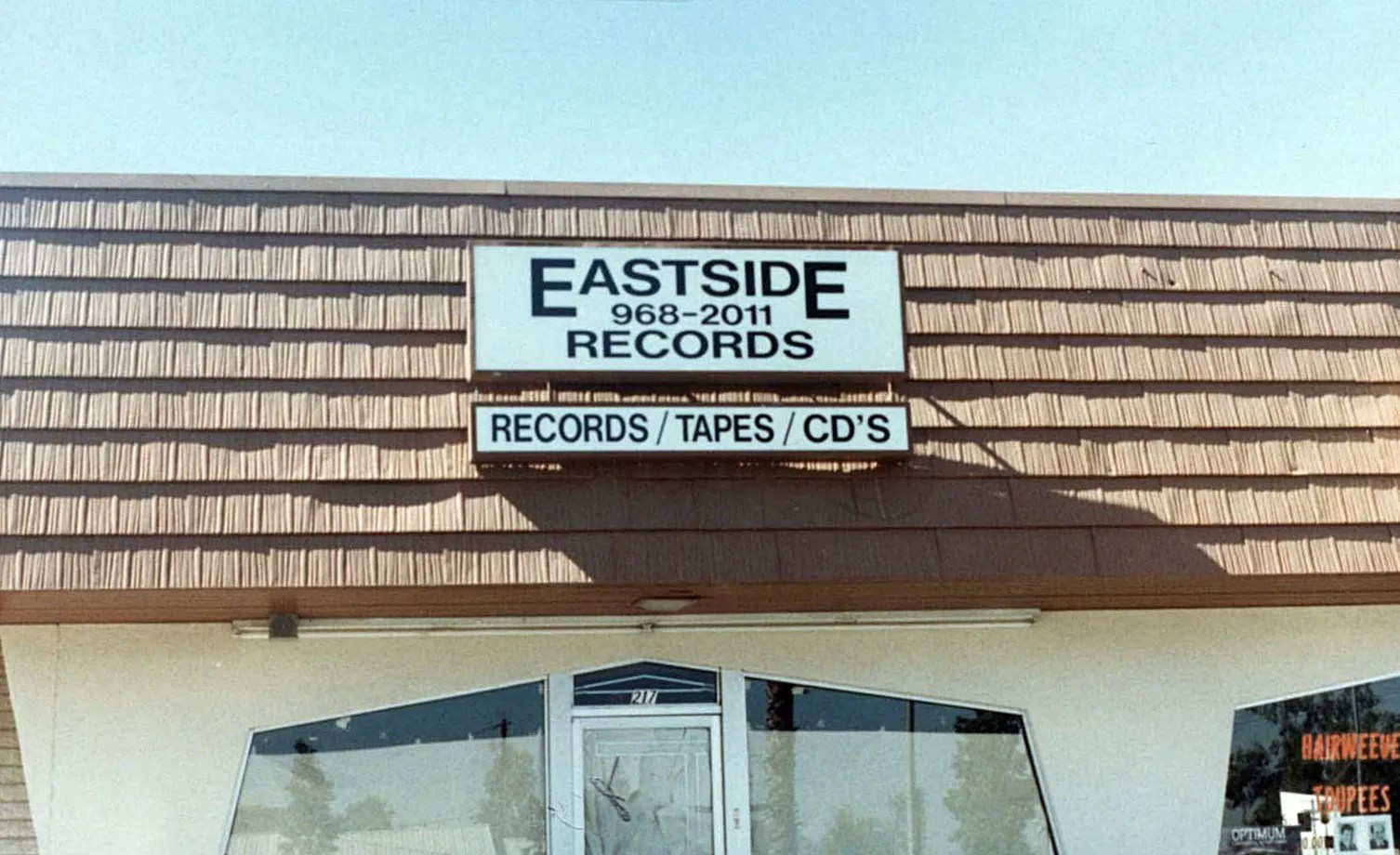
The original location of Eastside Records in the early ’90s.
Tempe History Museum
Eastside Records
217 W. University Drive, Tempe HQ Vape & Smoke in Tempe. Benjamin Leatherman
Currently: HQ Vape & SmokeThough not technically a music venue, the original location of Eastside Records on University Drive was an epicenter and meeting ground for the local music scene for close to 20 years. It also hosted more than a few shows in its day, both inside the store and out in the parking lot. 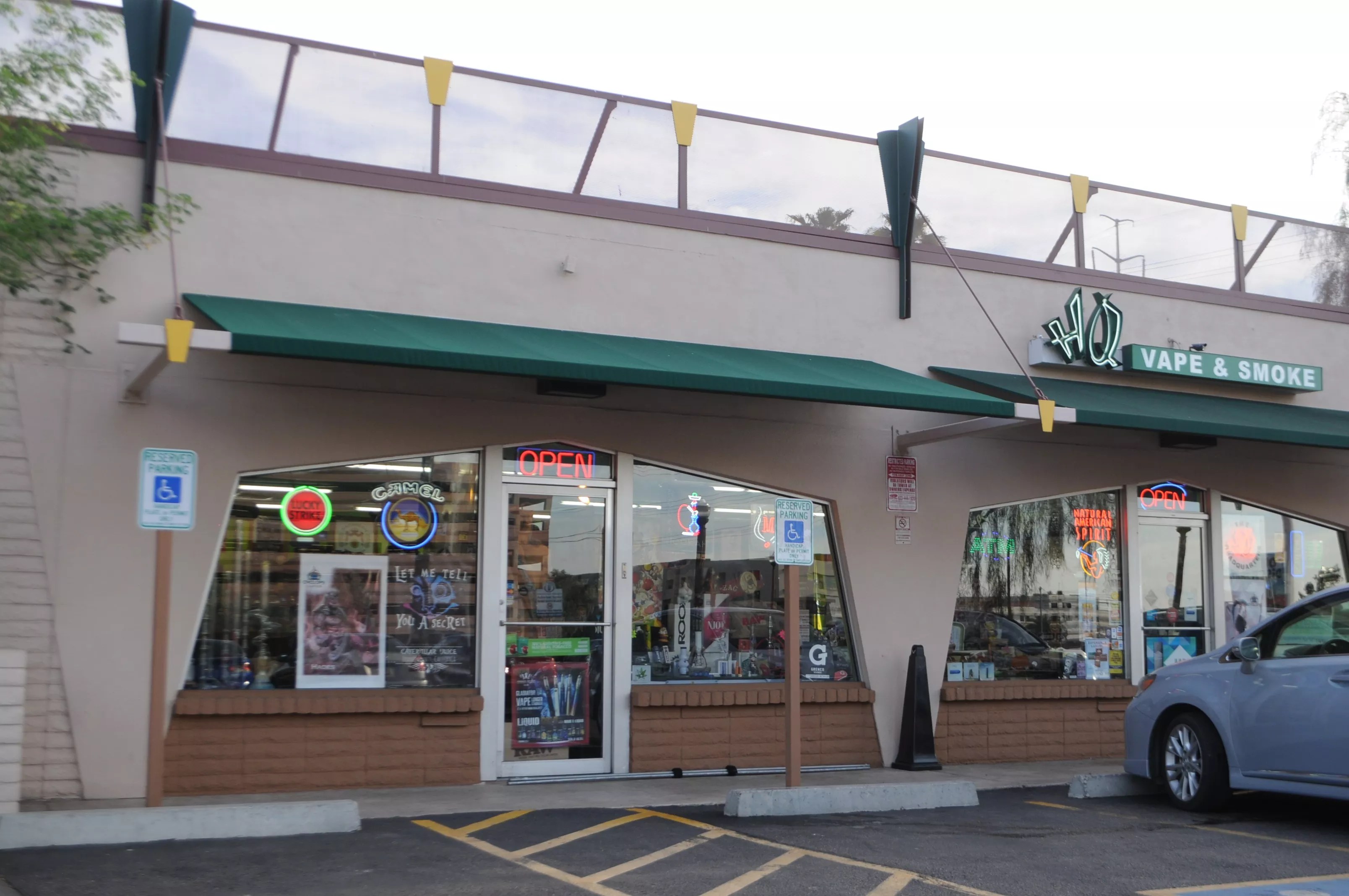
One of the biggest was a rowdy performance by surf/space rock act Man or Astro-Man? in 1995 that forced the landlord to ban future gigs at Eastside for a lengthy period. And though it wasn’t as uproarious, the final night at Eastside’s original home before its closure in 2010 featured Grave Danger and other locals performing in the aisles.
After its closure in 2010, neighboring smoke shop HQ Vape & Smoke (an iconic Tempe business in its own right) expanded into the space and doubled its size. Eastside co-owner Michael Pawlicki opened a few different pop-up versions of the store around Tempe over the past decade before settling on a space inside the Double Nickels Collective near the Yucca Tap Room.
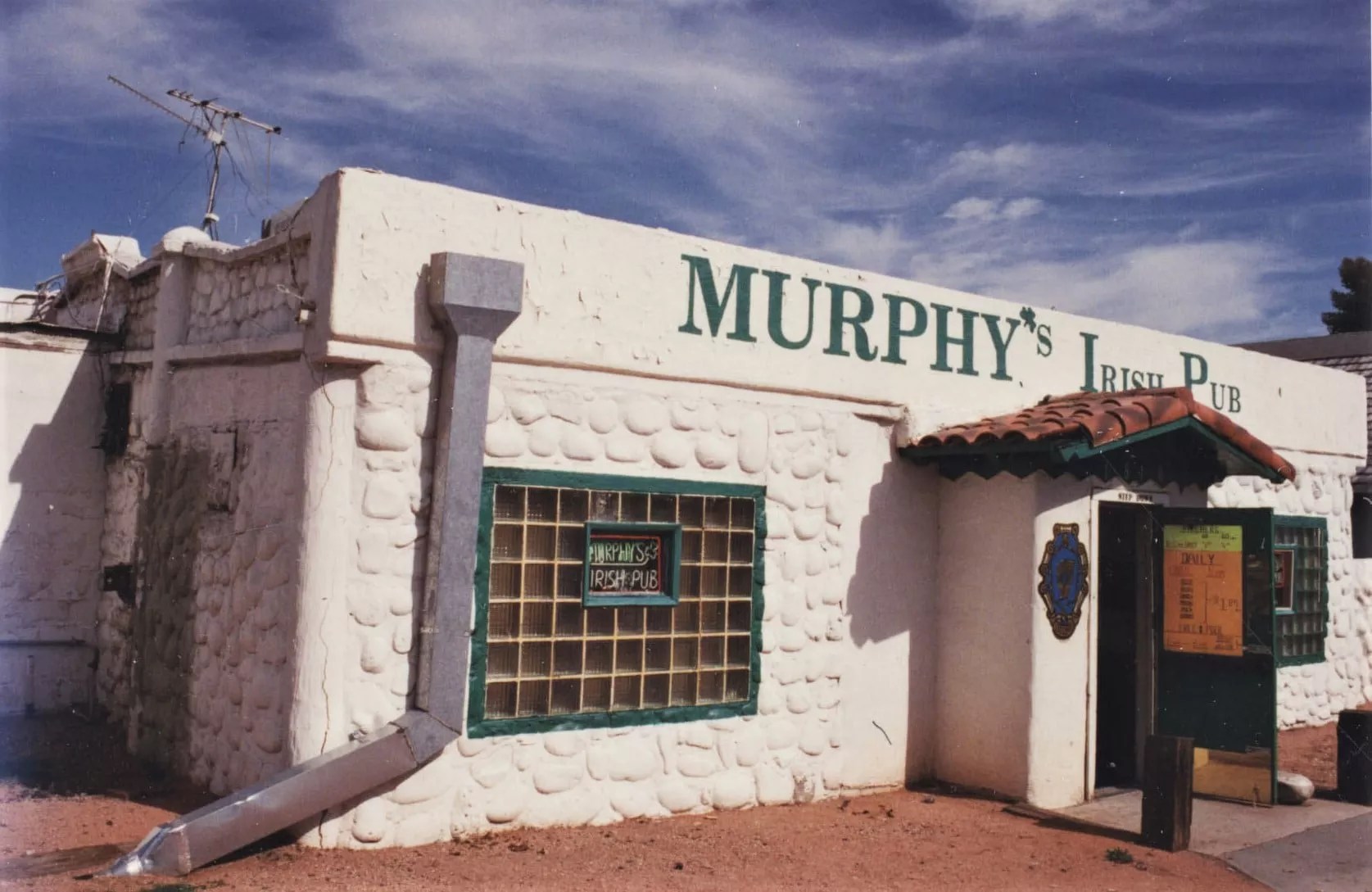
Murphy’s Irish Pub in a 1996 photo.
Tempe History Museum
The Oxbow/Murphy’s Irish Pub
1810 E. Apache Blvd., Tempe
Currently: Tempe TavernThe squat cobblestone structure located just east of McClintock Drive on Apache Boulevard may not be the oldest existing building in Tempe, but it does happen to be the oldest one currently operating as a music venue. In 1919, almost a century before it began hosting everything from punk and death metal to hip-hop, the building was the E.M. White Dairy Barn. It later was transformed into a commercial establishment in 1930 and later became a series of restaurants and bars.
Before it was Tempe Tavern, the property was the Oxbow in the 1940s and the New Oxbow Tavern in the 1970s. Throughout most of the ’90s, it served up many a pint as Murphy’s Irish Pub before its closure in 2001. A decade later, its current proprietors refurbished and remodeled the joint in 2011 into its current identity.
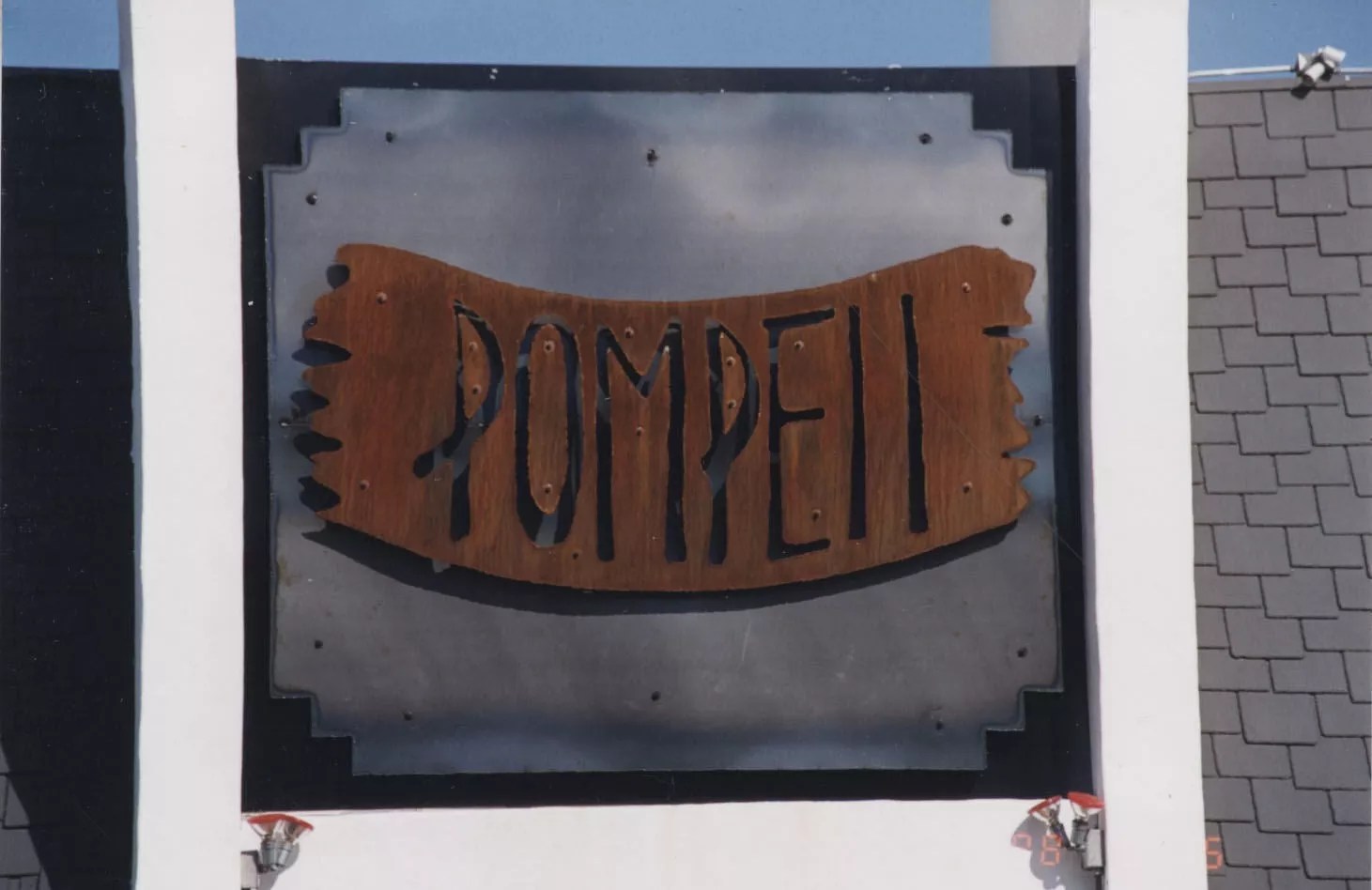
The sign for late-’90s dance club Pompeii.
Tempe History Museum
Pompeii/Club Freedom
919 E. Apache Blvd., Tempe
Currently: CVS Pharmacy parking lotThis now-demolished property on Apache Boulevard just east of Rural Road hosted multiple bars and nightspots over its lifetime: Sun Devil Lounge, Cactus Country Saloon, Utopia, Club Encounters, Max’s 919, Eclipse and Surprizes, just to name a few. Its best-known identities, though, came during the tenure of two iconic and influential dance joints that helped pave the way for the Valley’s modern-day EDM scene.
During the late ’90s, it was known as Pompeii, a two-story EDM haven renowned for its popular after-hours and memorable DJ nights, such as club promoter Jas Tynan’s Kind events. Around 2000, the property was purchased by onetime EDM/live entertainment guru Steve Kushnir and went on to greater fame as Club Freedom. Superstar DJs like Paul Oakenfold, John Digweed and Paul Van Dyk performed at the club, as did future local EDM luminaries such as nightlife impresario Steve LeVine, Relentless Beats’ owner Thomas Turner and DJ/sound engineer Timothy Heit.
Kushnir pulled the plug on Freedom in May 2004 due to waning turnout, leaving a sizable void in the Valley’s DJ scene that local nightclubs in Tempe and Scottsdale attempted to fill.
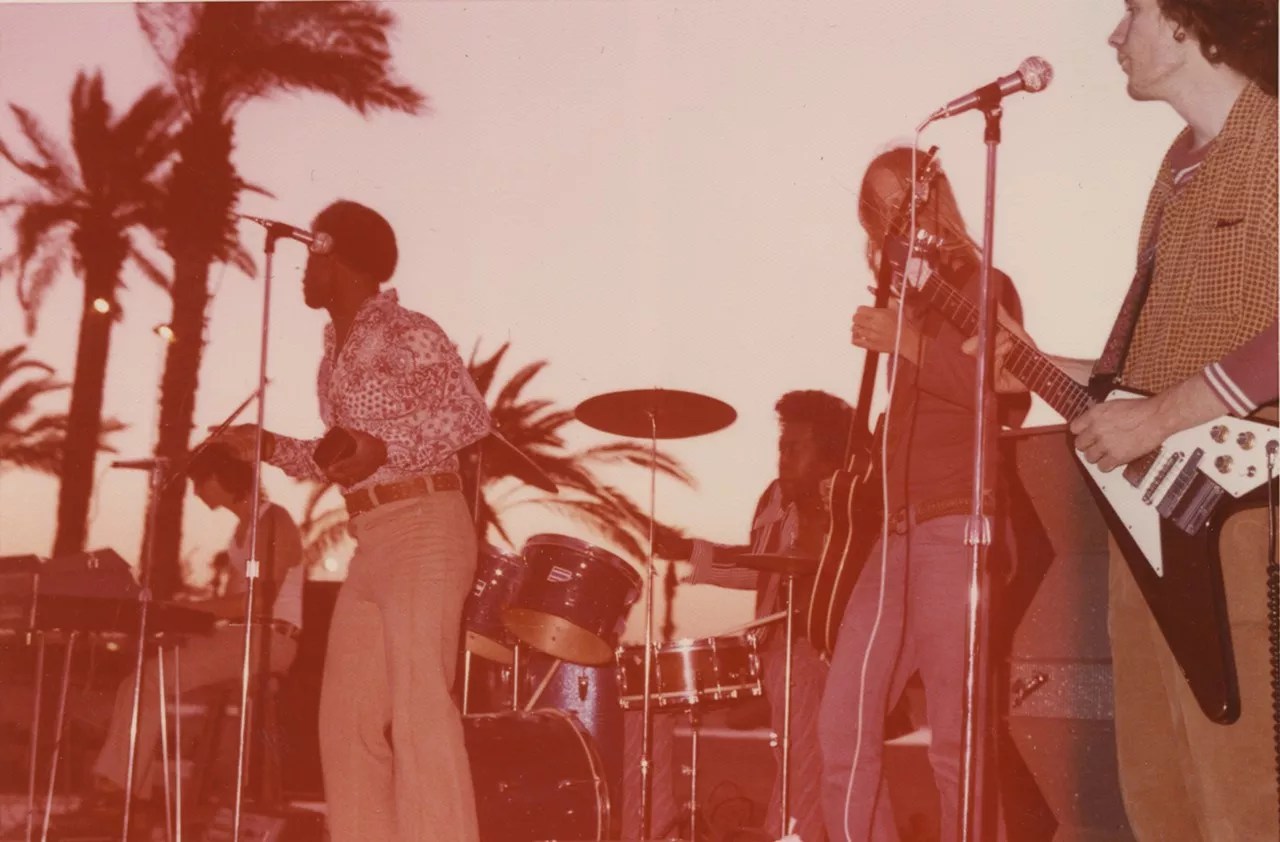
Many bands played at Big Surf over the years.
Tempe History Museum
Big Surf
1500 N. McClintock Drive, Tempe A scene from Big Surf’s demolition in 2022. Benjamin Leatherman
Currently vacant This iconic Tempe water park was nothing if not historic. After debuting in 1969, it not only became the longest-running attraction of its kind in Arizona but also was the first-ever wave pool in the U.S. In the 1970s, people also turned out in droves for multiple outdoor concerts at Big Surf by noteworthy acts.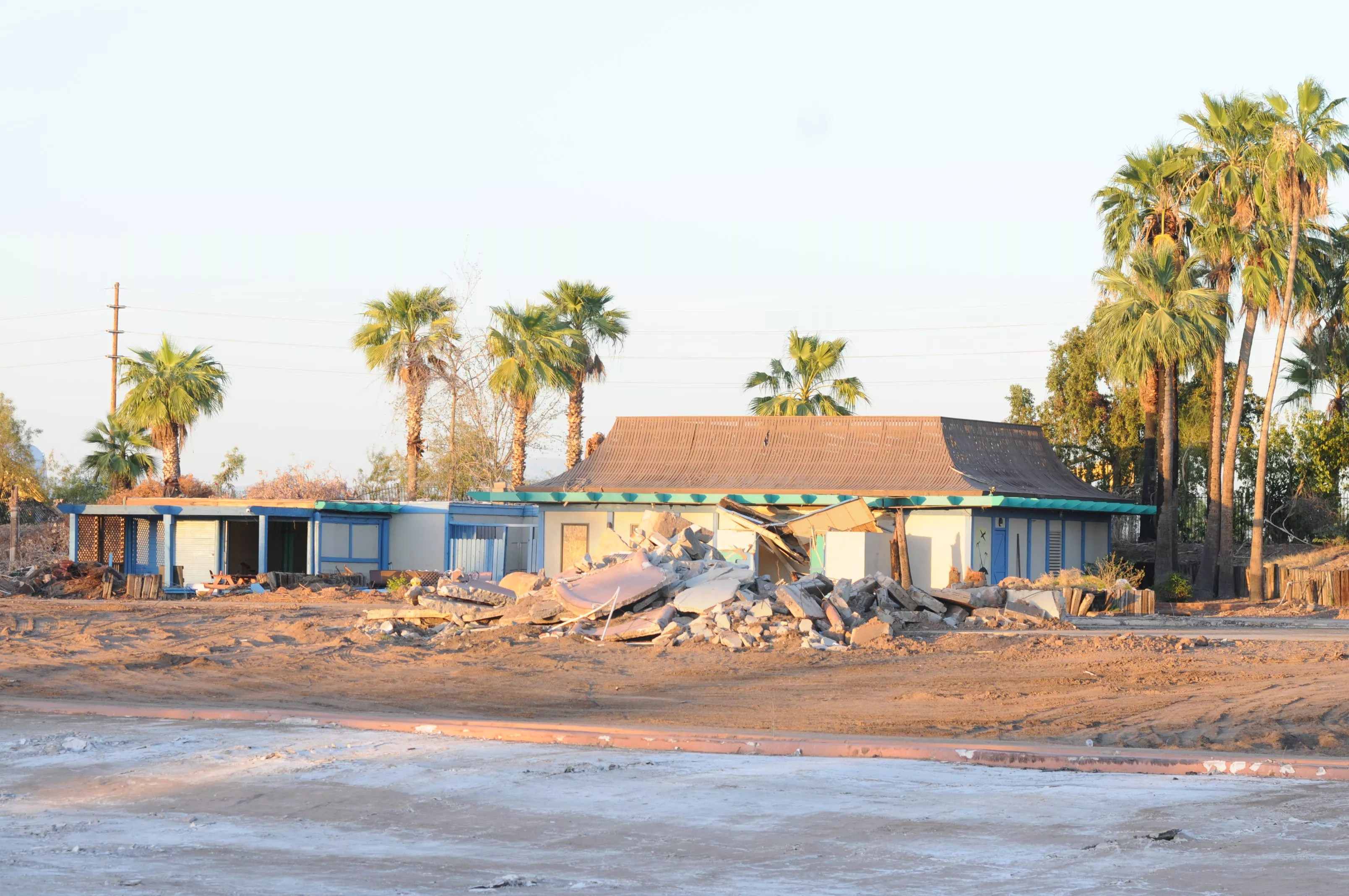
Classic rock and pop legends like Deep Purple, Steely Dan, Boz Scaggs and Foghat all performed amid the palm trees and Polynesian kitsch of the park. (Sometimes the outdoor setting was a bit hazardous, like when Pink Floyd reportedly pulled the plug midway through its September 1972 set due to rain.) Other renowned names who visited Big Surf for shows over the decades include Elton John, Stevie Wonder, Blue Öyster Cult, Sting and the Red Hot Chili Peppers.
Fast-forward to the 2010s, and the water park continued hosting blockbuster music events. Steve LeVine Entertainment put on three editions of its Soundwave music festivals in 2011 and 2012 at Big Surf. The annual Wet Electric also brought in noteworthy DJs like Dillon Francis, Diplo and Flux Pavillion from 2013 to 2019.
The good times at Big Surf dried up in 2022 when it was sold by its owners after a two-year closure caused by the pandemic. A California real estate developer acquired the property for $49 million and demolished the attraction to pave the way for a future industrial park.
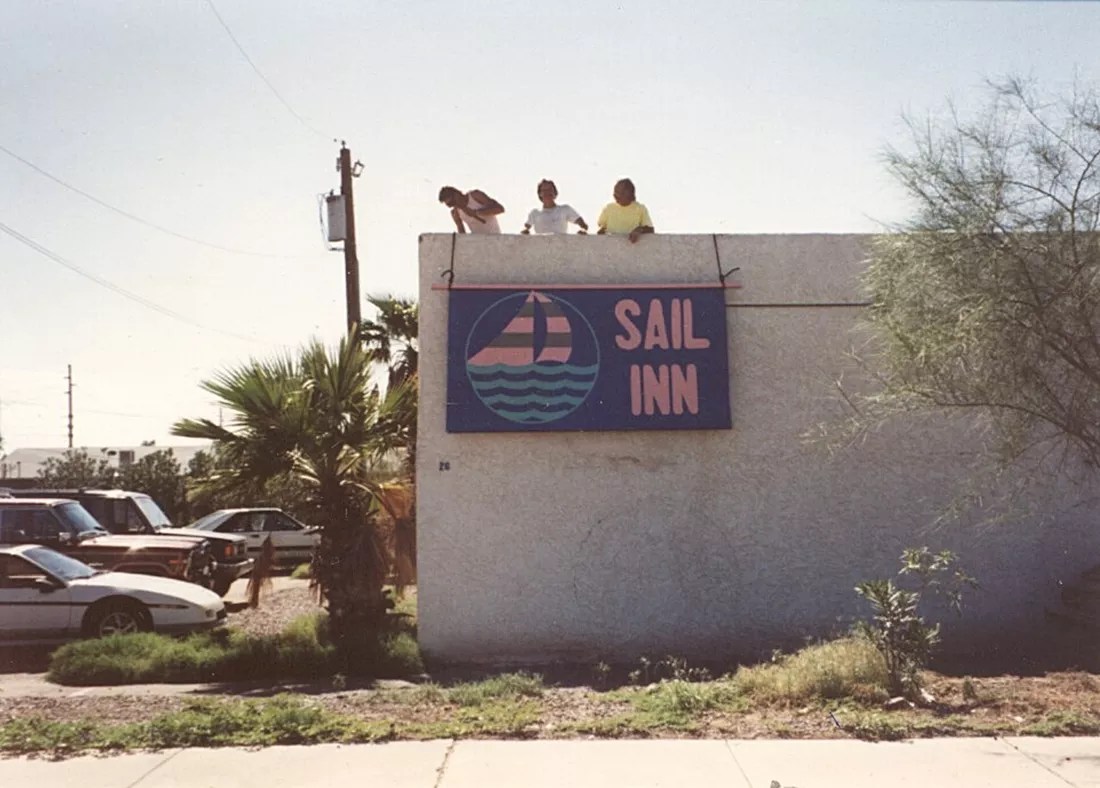
A photo of the Sail Inn prior to its opening in 1990.
Gina Lombardi
The Sail Inn
26 S. Farmer Ave., Tempe
Currently: The Lodge Sasquatch KitchenIn 1990, Sail Inn owner Gina Lombardi and her business partners turned what was originally a ramshackle dive known as the Last Chance Saloon into a thriving music destination. It spent the next 24 years as one of Tempe’s favorite places to drink, hang out, or catch a show. Local musicians and bands were big fans of the place during its lifespan, be it blues artists in the early ’90s, the members of Mill’s famous jangle-pop era, or more modern acts like Dry River Yacht Club, Japhy’s Descent and The Sugar Thieves.
The good times came to an end in 2014 when the property was sold to developers and transformed into the new home for Chef Aaron May’s Sasquatch-themed restaurant/bar The Lodge. Sail Inn’s patrons will be pleased to know that the establishment retains some structural elements of its former identity, including the property’s outdoor amphitheater, which serves as the backdrop for the patio.
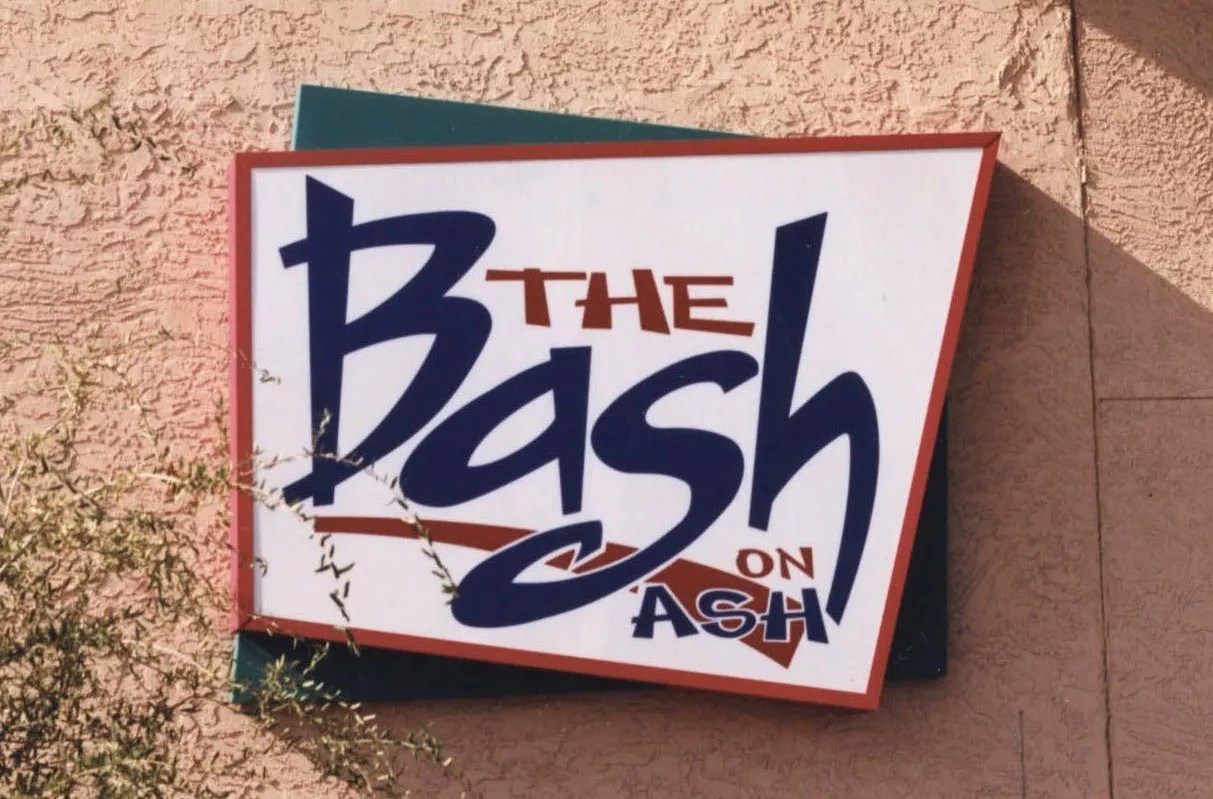
The Bash on Ash in 1997.
Tempe History Museum
The Bash On Ash
230 W. Fifth St., Tempe The offices of Education at Work. Google Maps
Currently: Education at WorkBig bashes took place in this now-defunct concert hall attached to the equally extinct sports bar McDuffy’s, and we aren’t just referring to the times pro wrestlers battled inside. There were also costume balls, swing parties and a variety of other nightlife events. The main attraction, though, was concerts, which The Bash hosted in abundance after opening in 1997. 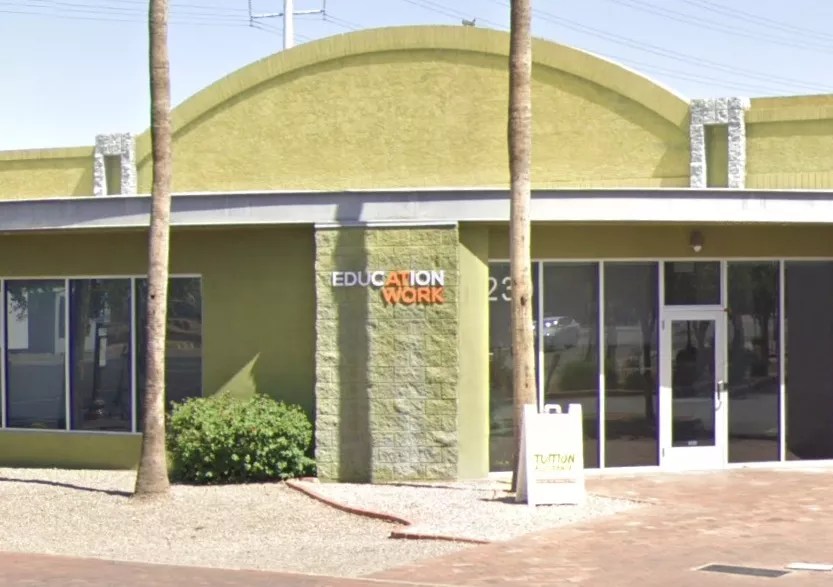
Loads of raucous local CD release parties happened within the cavernous main room, including shindigs by Morse Code, Mourning Maxwell, Victims in Ecstacy, Kings of Pleasure and Blessedbethyname. As one of the snazzier mid-sized venues locally, it saw a lot of use by Valley artists with significant followings, as well as underground hip-hop acts, up-and-coming indie bands, punk and ska legends and hordes of hard rock and death metal groups.
The Bash enjoyed a six-year run, but a combination of waning crowds, the post-9/11 economic funk, and a downturn of interest in live music convinced owner Scott Adams to eschew concerts in 2004 and turn it into a nightclub. It didn’t last, and he consequently brought back The Bash on Ash the following summer, only to close both it and McDuffy’s in 2005. The building is now occupied by the offices of Education at Work.
Green Room
560 S. College Ave., Tempe The now-closed Nush in Tempe. Google Maps
Currently: VacantEver strolled past this particular College Avenue establishment on your way to Sun Devil Stadium over the decades? No doubt you’ve seen the series of sports bars and drinkeries that have come and gone from the property. Back in 1999, it was home to the Green Room, one of the first music venues overseen by local concert promoter Charlie Levy.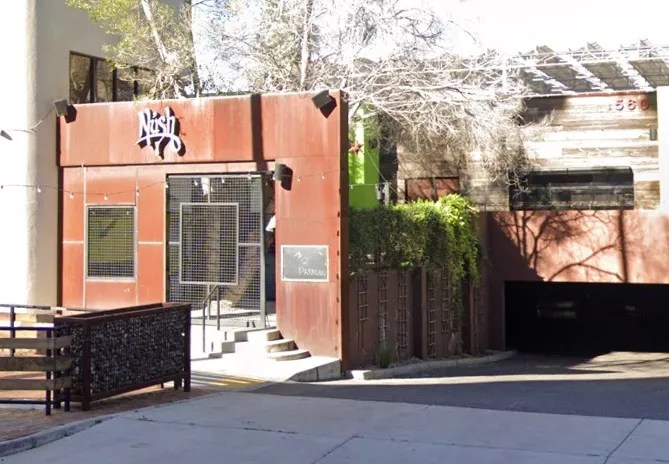
Let’s set the stage: It’s late 1998 and the future owner of Crescent Ballroom and Valley Bar had left Nita’s Hideaway. Levy had chosen to focus on managing local bands and was approached by the owners of Fumbles, a foundering bar located in the space, about bringing his clients in to perform at the business. Many of Levy’s cohorts from Nita’s, such as soundman Jamah Ruhe and the members of the Bombshelter DJs, followed him to the Green Room. And the place prospered. Jimmy Eat World held the release party for their influential album “Clarity” at the spot. Meanwhile, Levy also brought in such bands as Get Up Kids and Superchunk.
Levy and his crew departed a year or so later, and the Green Room carried on for a spell before closing. Since then, a series of sports bars and restaurants have taken over the property, including its most recent tenant, a now-defunct Mediterranean restaurant called Nush.
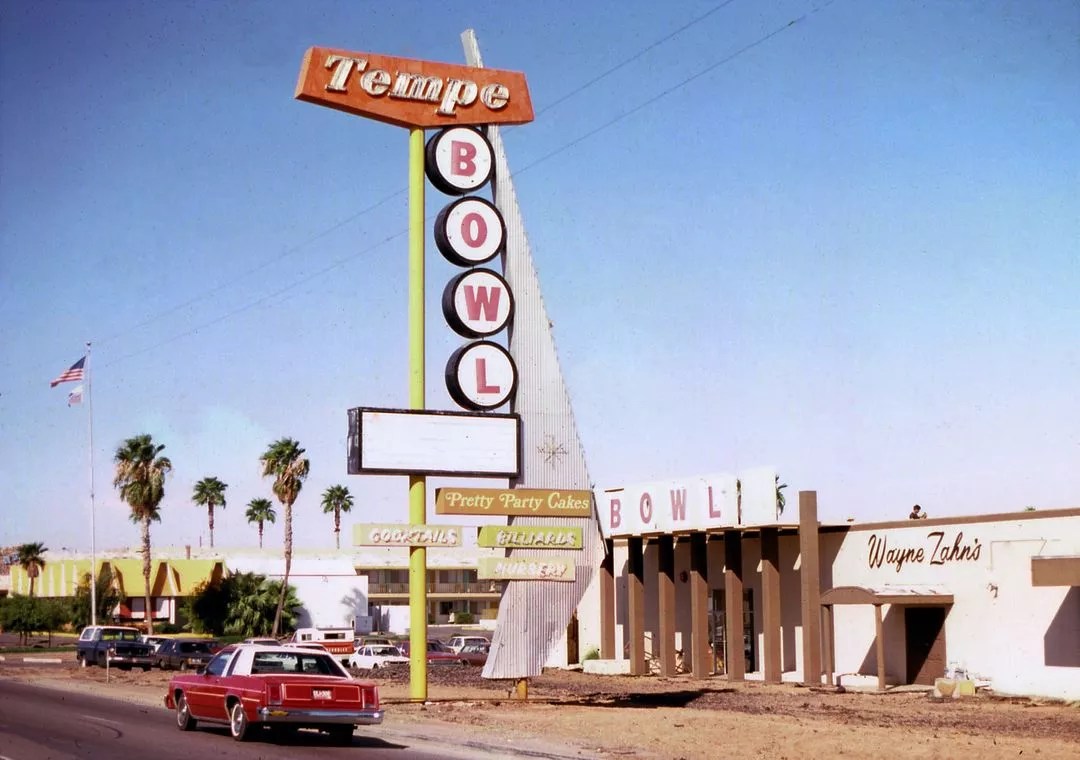
The exterior of Tempe Bowl in 1983.
Tempe History Museum
Tempe Bowl
1100 E. Apache Blvd., Tempe
Currently: Apollo ApartmentsIn what some folks fondly remember as the Valley’s version of Chicago’s infamous Fireside Bowl, the long-defunct Tempe Bowl was the site of many rock, pun, and ska gigs in the late 1990s. After the neighboring Electric Ballroom lost its liquor license in 1997, shows booked at the ailing venue were quickly moved next door to the bowling alley. Christine Zahn, Tempe Bowl’s owner, was receptive to the situation and allowed further concerts at her business in the following months. It quickly became a popular all-ages venue frequented by punks and straight-edge kids.
The shows helped Tempe Bowl’s bottom line, but it wasn’t enough to keep the place alive. It closed in the early 2000s and was transformed into the Southwest Institute of Healing Arts. The property has since been razed and is now a multimillion-dollar condo project set to open later this year.
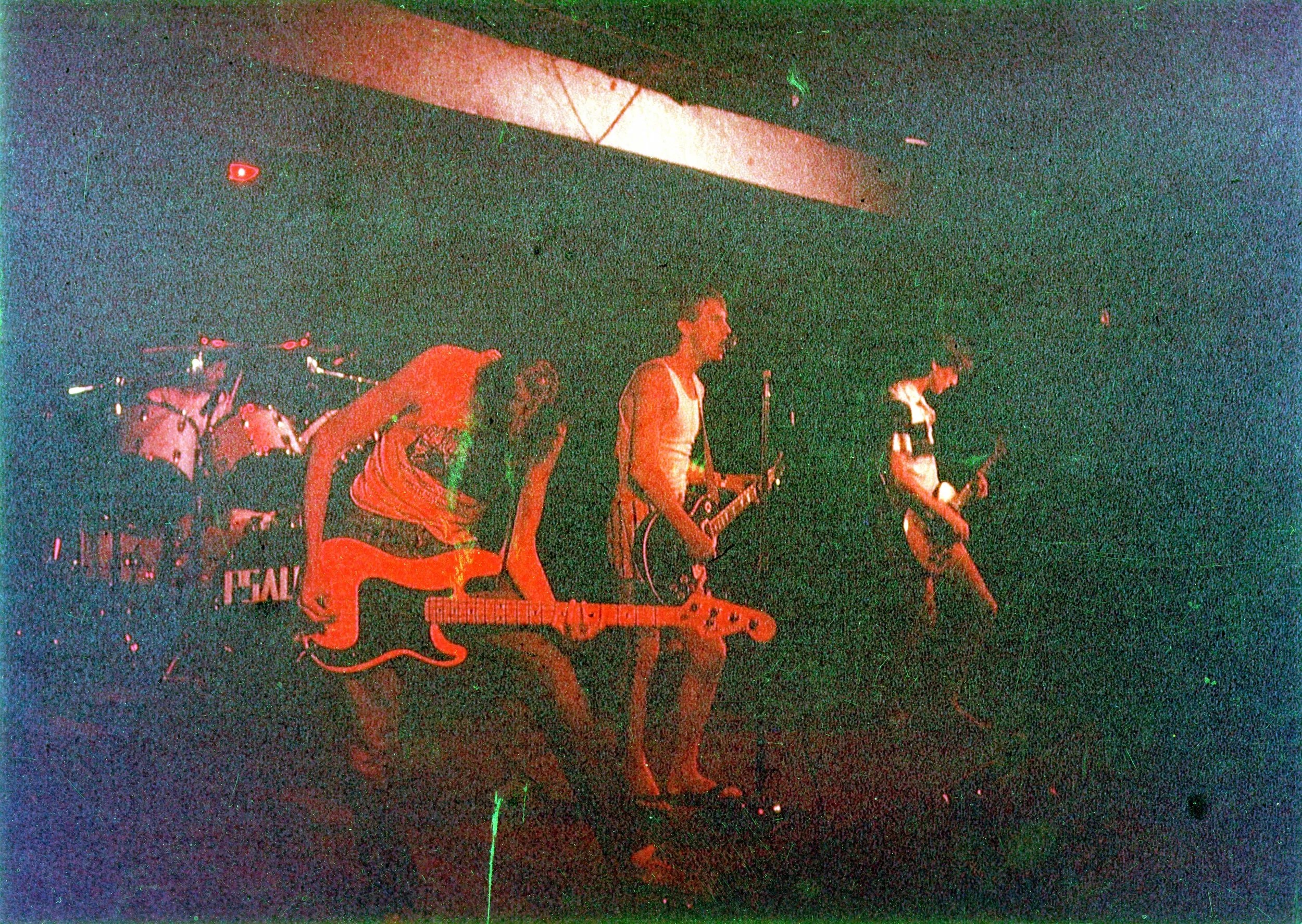
The Psalms performing at Merlin’s in 1982.
Tempe History Museum
The Star System/Merlin’s
400 S. Mill Ave., #348, Tempe
Currently: Q & BrewTempe’s Danelle Plaza has experienced its fair share of Valley music history. Starting in the late ’70s, The Star System operated in a secluded corner of the shopping center, showcasing both local talents and touring acts from the budding New wave and punk scenes. Originally designed as a disco, complete with a spacious dance floor beneath an “immersive canopy of twinkling stars,” groups like The Plugz, Fear and The Go-Go’s graced the venue with their performances. The Star System was also a vital outlet for influential and iconic local acts of the era, including Billy Clone and the Same, Killer Pussy, The Feederz, Meat Puppets, and Blue Shoes.
In 1980, new owners renamed the place Merlin’s but kept the focus on emerging and experimental sounds. It was the stomping grounds for noisy art rockers Sun City Girls, the skate-punks of JFA and New wave act The Jetzons. Modern rock band The Psalms, which featured Doug Hopkins and Bill Leen prior to their stint in Gin Blossoms, were also regulars at Merlin’s.
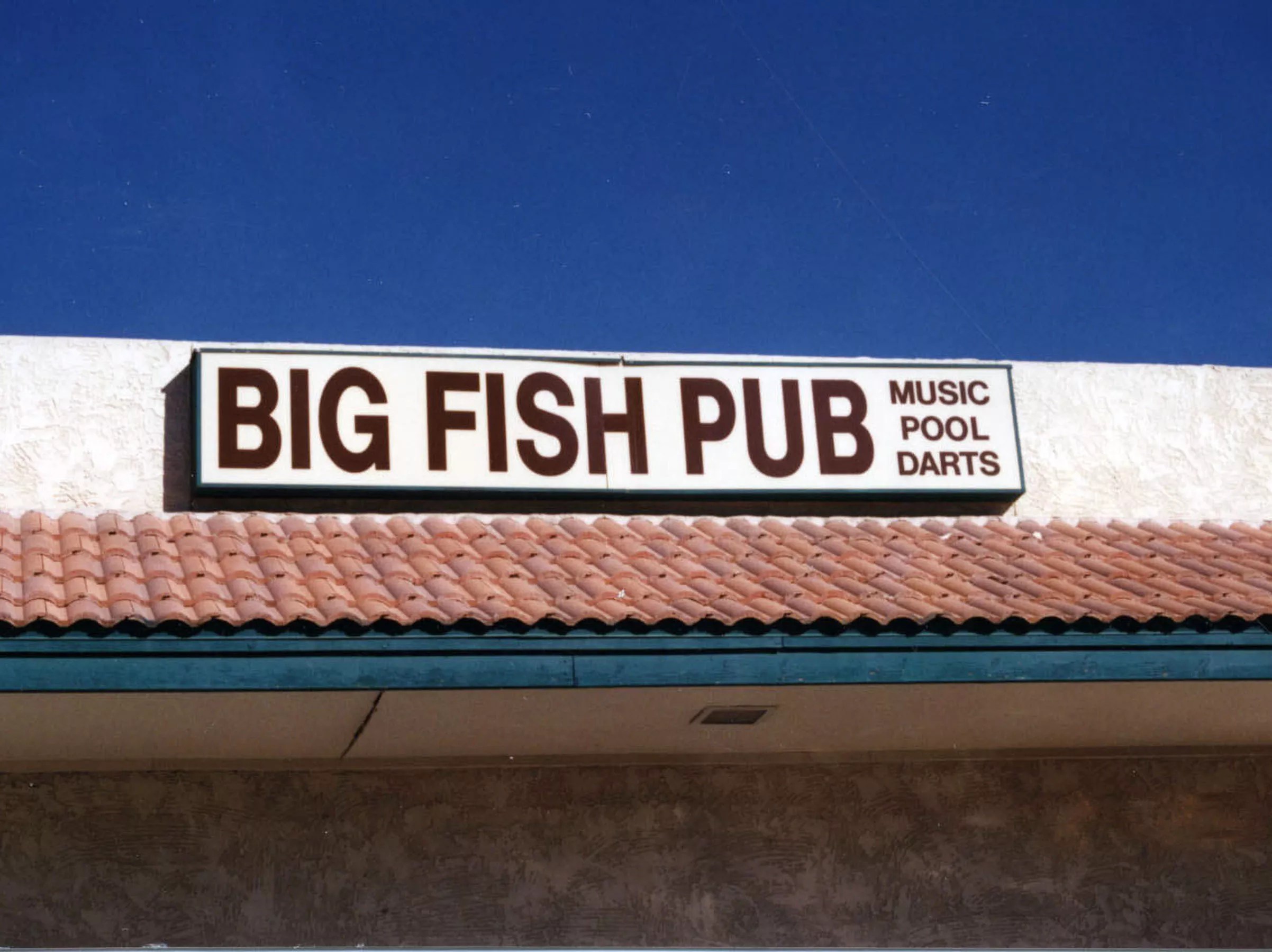
A 1996 photo of Big Fish Pub.
Tempe History Museum
Big Fish Pub
1954 E. University Drive, Tempe The former home of Big Fish Pub. Google Maps
Currently: 360 Physical TherapyOpened in 1995 by original owner Donny Johnson (currently the general manager for Lucky Man Concerts), Big Fish Pub was slightly removed from the popular Mill Avenue scene but still featured many of the same acts. As the years wore on, the pub also hosted many renowned hard rock and alternative acts during their formative years, including A Perfect Circle, Sevendust, Eagles of Death Metal, 30 Seconds to Mars and Chester Bennington’s pre-Linkin Park band, Grey Daze.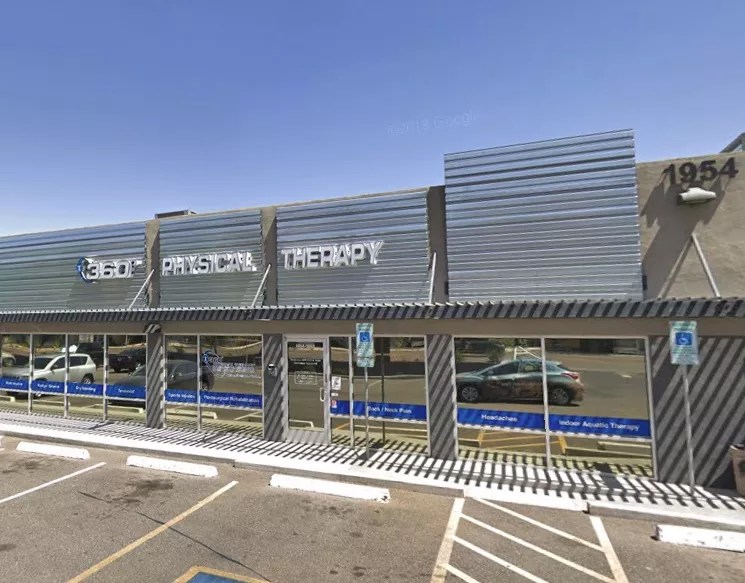
Johnson sold the bar in 2005 after a decade of ownership to local entrepreneur Mark DiCarlo. It became more of a blues/R&B joint before changing owners again in 2008, this time being purchased by proprietor Victor Boiseau, who returned the place to its rock club roots.
Despite his best efforts to sustain the Big Fish, he reportedly got into a spat with the owners of the strip mall that housed the bar over rent and other issues. As a result, Boiseau closed the pub in 2014 and moved it to Mesa (where it lasted less than a year). Since then, its original home underwent a major remodeling and is now home to one of the Valley locations of 360 Physical Therapy.
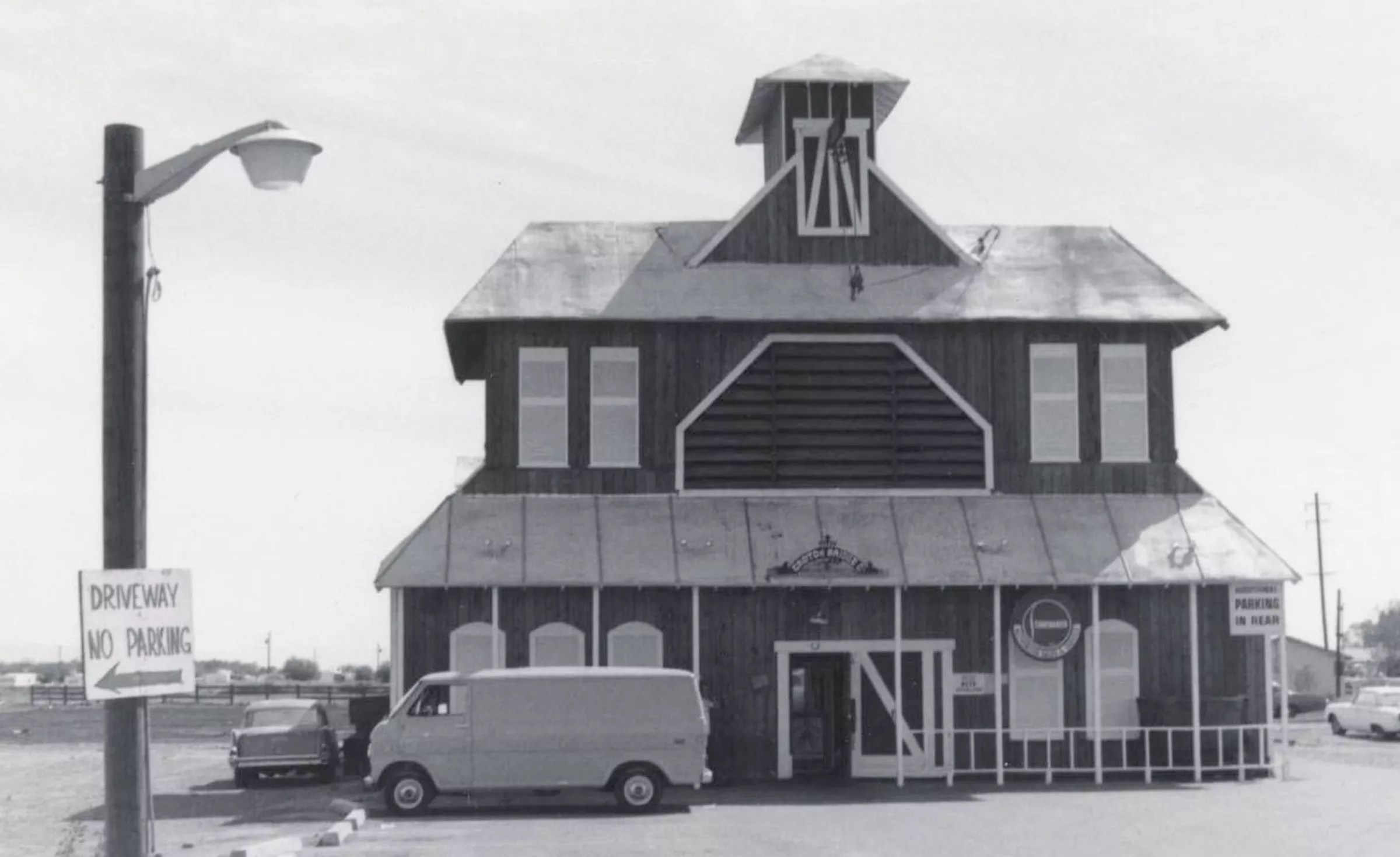
The old Minder Binder’s on McClintock Drive in Tempe in 1972.
Courtesy of Tempe History Museum
Minder Binders
715 S. McClintock Drive, Tempe
Currently: Social HallWhen it came to kitschy spots, it was hard to top Minder Binders. After all, the place was built to resemble a huge red barn and boasted a bucolic theme and an array of antiques inside. Opened in 1972, it was aimed at college students and beckoned them with five different bars, nickel beer nights, dance parties and shows in its backyard or the upstairs area. Veruca Salt played there once, as did bands like Flotsam and Jetsam, Agent Orange, Voodoo Glow Skulls, Infectious Grooves and even Hole (back before Courtney Love went completely nutso).
Minder Binders bought the farm around 2005, and the property sat almost a decade as a decrepit eyesore along McClintock Drive before being completely reconstructed and remodeled in 2014. It’s now known as Social Hall, an expansive restaurant and bar with none of the ostentatiousness of its predecessor.
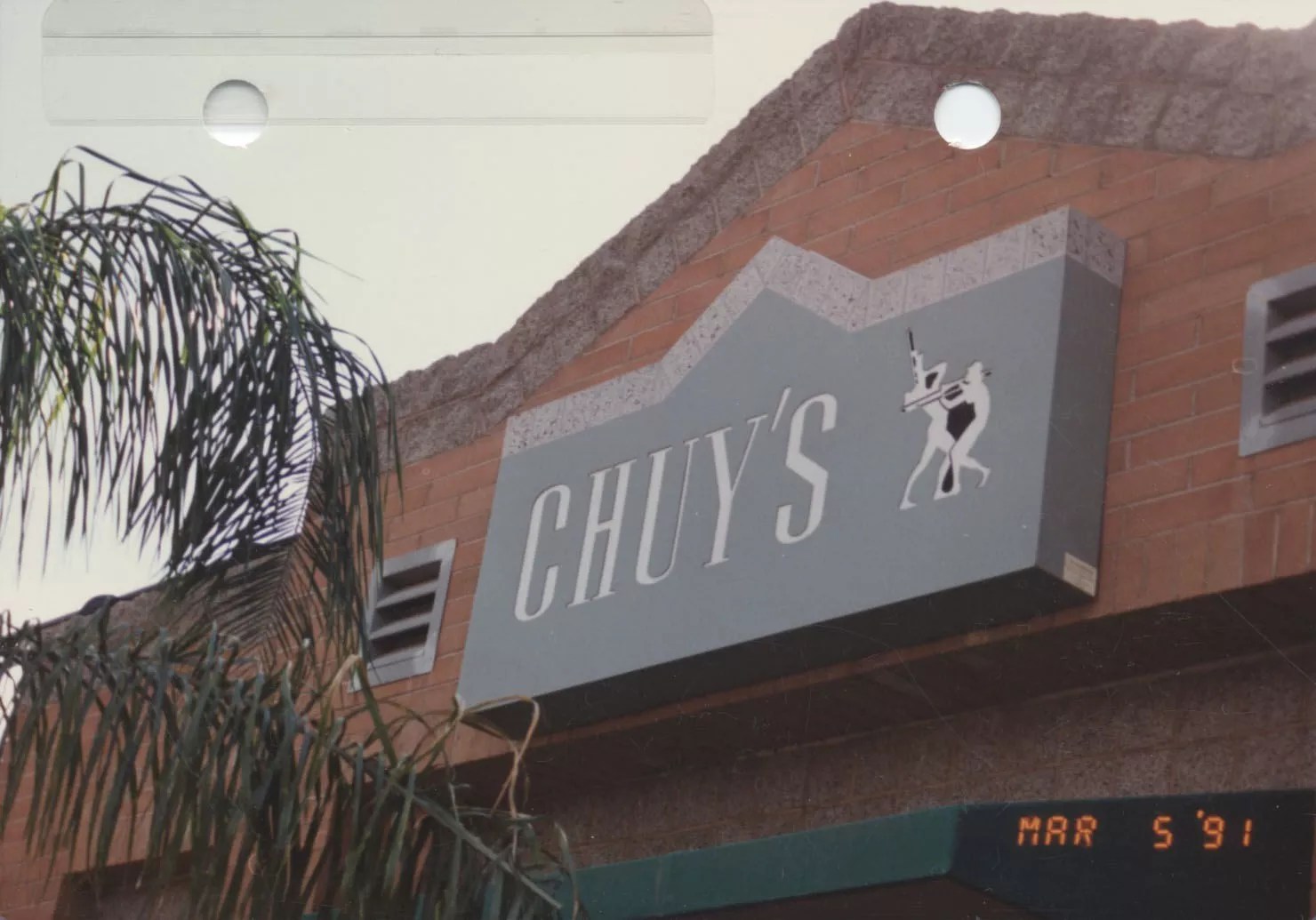
Rock and blues spot Chuy’s, which was located in Hayden Square and operated from 1989 until 2002.
Tempe History Museum
Chuy’s
Multiple LocationsThe history of Chuy’s encompasses not one, but three separate bygone venues in downtown Tempe, each with its own particular vibe and preferred sound. The first location originated in the 1970s and was known as Chuy’s Choo-Choo, a ground-level bar at the now-demolished Casa Loma Hotel near Third Street and Mill Avenue that started featuring live acts around the late 1970s.
In 1981, local musician Jim Simmons and his wife, vocalist Nancy Jackson, took over the spot, 86ed the “Choo-Choo” portion of this moniker, and turned it into a hot spot for jazz and blues artists. “Every big jazz and blues person you could think of played there, like the Crusaders and John Lee Hooker,” says local concert promoter Danny Zelisko. Other visitors included Charlie Musselwhite, the late Jaco Pastorius, Branford Marsalis, McCoy Tyner and Gatemouth Brown.
Due to real-estate development in downtown, Simmons and Jackson moved Chuy’s twice during the 11-year span they ran the club, eventually winding up in what then was known as Hayden Square in 1989 and spending the next three years hosting rock and alternative concerts until its closure in October 1992.
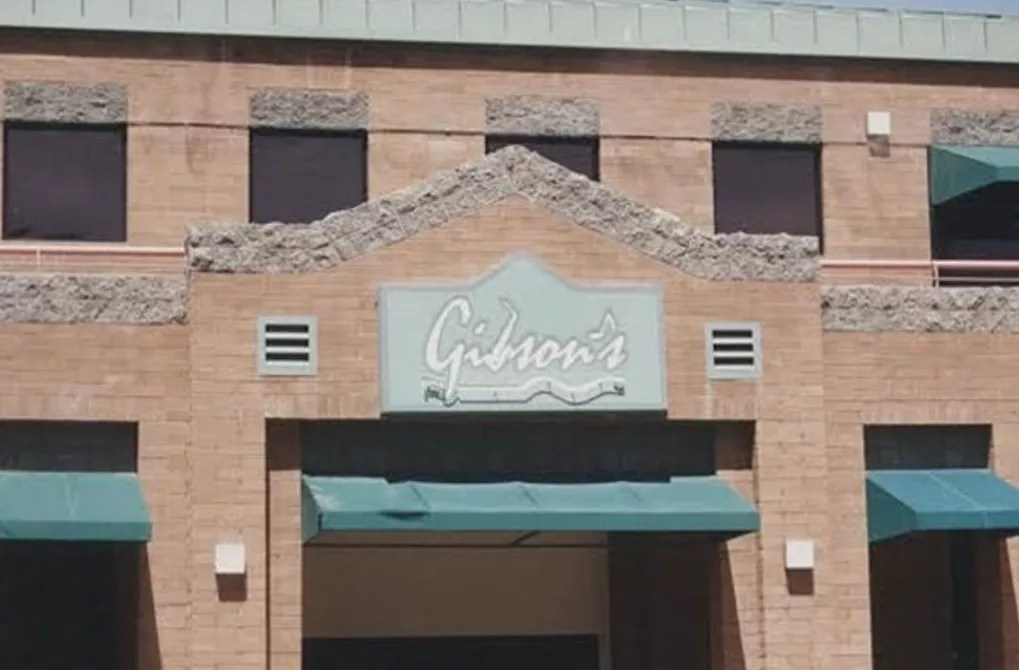
Gibson’s in Hayden Square was a rock haven.
Tempe History Museum
Gibson’s
410 S. Mill Ave., Tempe
Currently: VacantFast-forward a year and a half (and an ownership change) later to 1994 and what was once Chuy’s became Gibson’s, a preferred spot for many music fans. Its balcony was a great place for bird’s-eye views of the bands (not to mention a closer look at the row of namesake guitars adorning the ceiling), the higher-than-normal stage gave an aura of importance to anyone performing on it, the sound was always spot on and it was where many saw some of their biggest rock heroes during the height of their success.
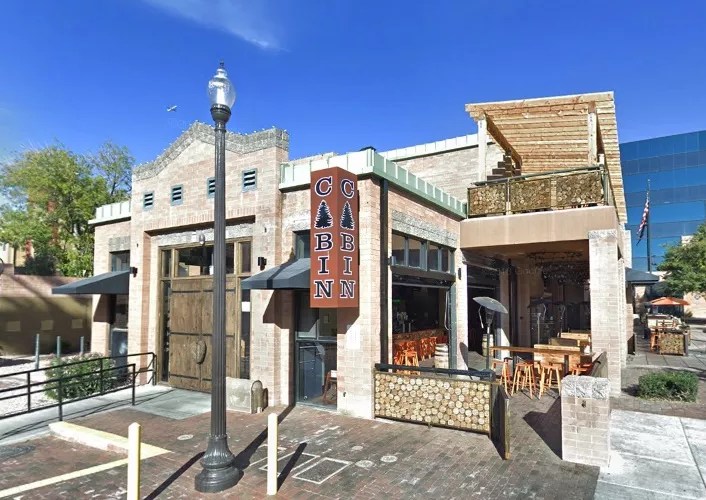
The Cabin Tempe.
Google Maps
Zelikso was one of ’em. “I loved shows at Gibson’s,” he says. “There was that balcony and you could look down on whoever was playing.”
Gibson’s was open for only five years, but hosted plenty of famous acts, including Lords of Acid, Gravity Kills, Suicidal Tendencies, Supersuckers, Cibo Matto and Soul Coughing.
In 2000, the bar went hippie as Have a Nice Day Cafe for a few years before becoming a series of different clubs, including Margarita Rocks, Moonshine Whiskey Bar and The Cabin Tempe. The property is currently vacant but we’re guessing it will have a new tenant before too long.
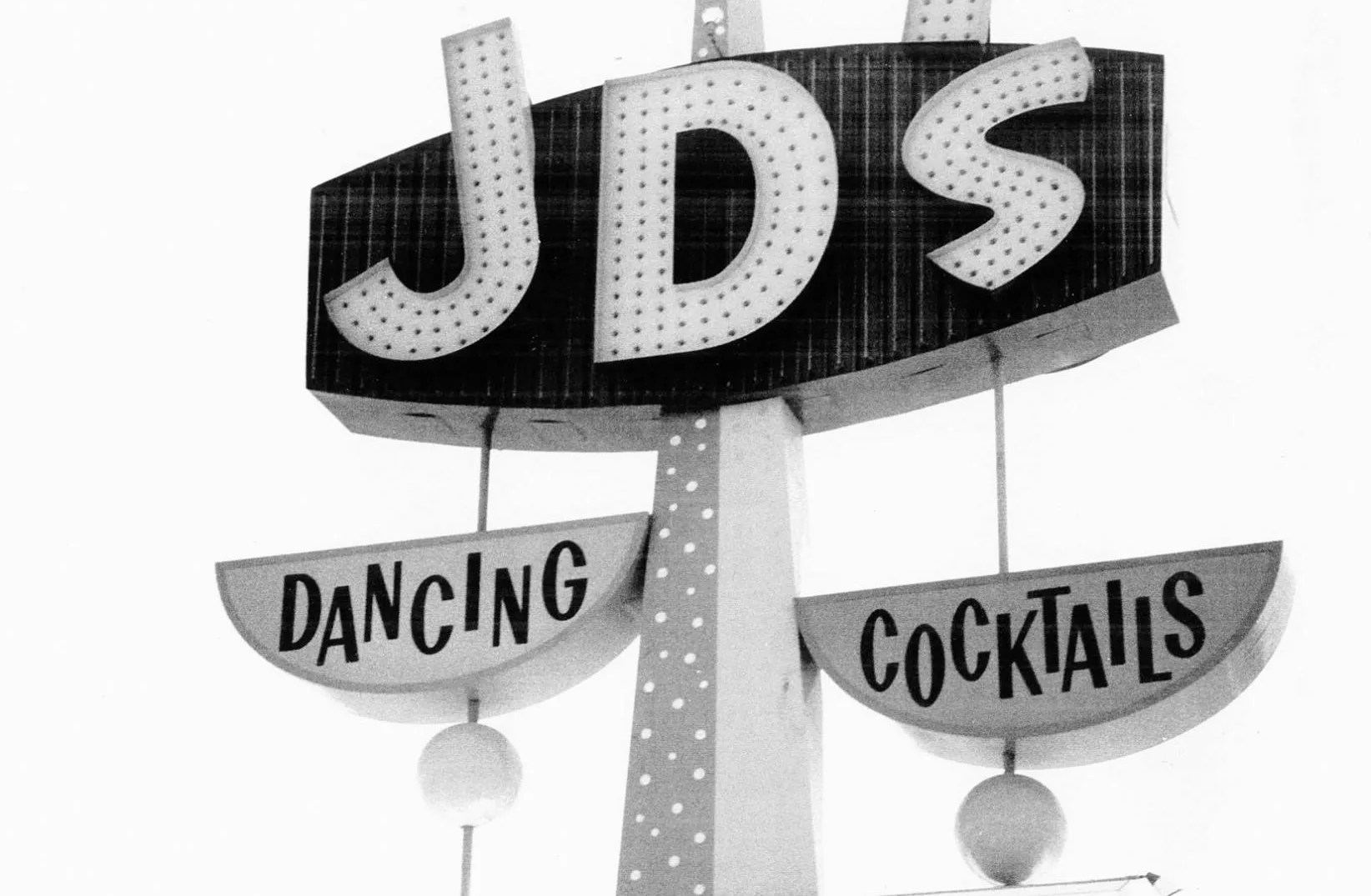
JD’s was one of the Arizona spots where Waylon Jennings got his start.
Tempe History Museum
JD’s
825 N. Scottsdale Road, Tempe The now-closed 4-Day Furniture in Tempe. Google Maps
Currently: VacantYou may not know it from its shabby appearance, but the now-closed furniture store next door to the Dream Palace strip club was once considered hallowed ground. A lifetime ago, it was the location of JD’s, a name that’s likely familiar to fans of the late Waylon Jennings. 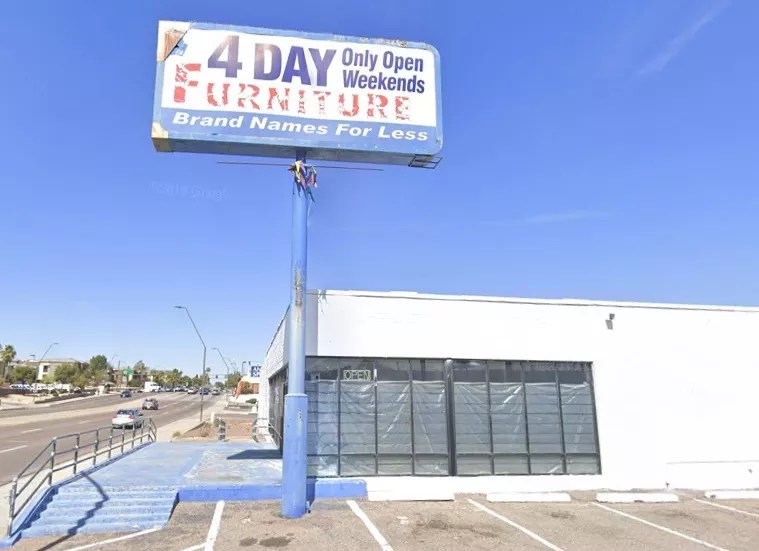
The two-floor nightclub, which was located at what was then the bottom of the dry Salt River, debuted in the mid-’60s and featured rock bands downstairs and country music upstairs. The outlaw crooner and longtime Valley resident performed their often, honing his craft and gaining exposure to the country music world. Other Hall of Famers that graced JD’s and packed ’em in by the thousands were Johnny Cash, Willie Nelson and the Valley’s own Mike Condello.
The club survived into the ’70s, albeit after a number of setbacks. After the river bed flooded in 1965, significant water damage caused the place to close for weeks. It also changed ownership and names before being gutted by a fire in 1976 and eventually turning into a retail store in 1978. It was most recently a furniture outlet, which went out of business a few years ago.
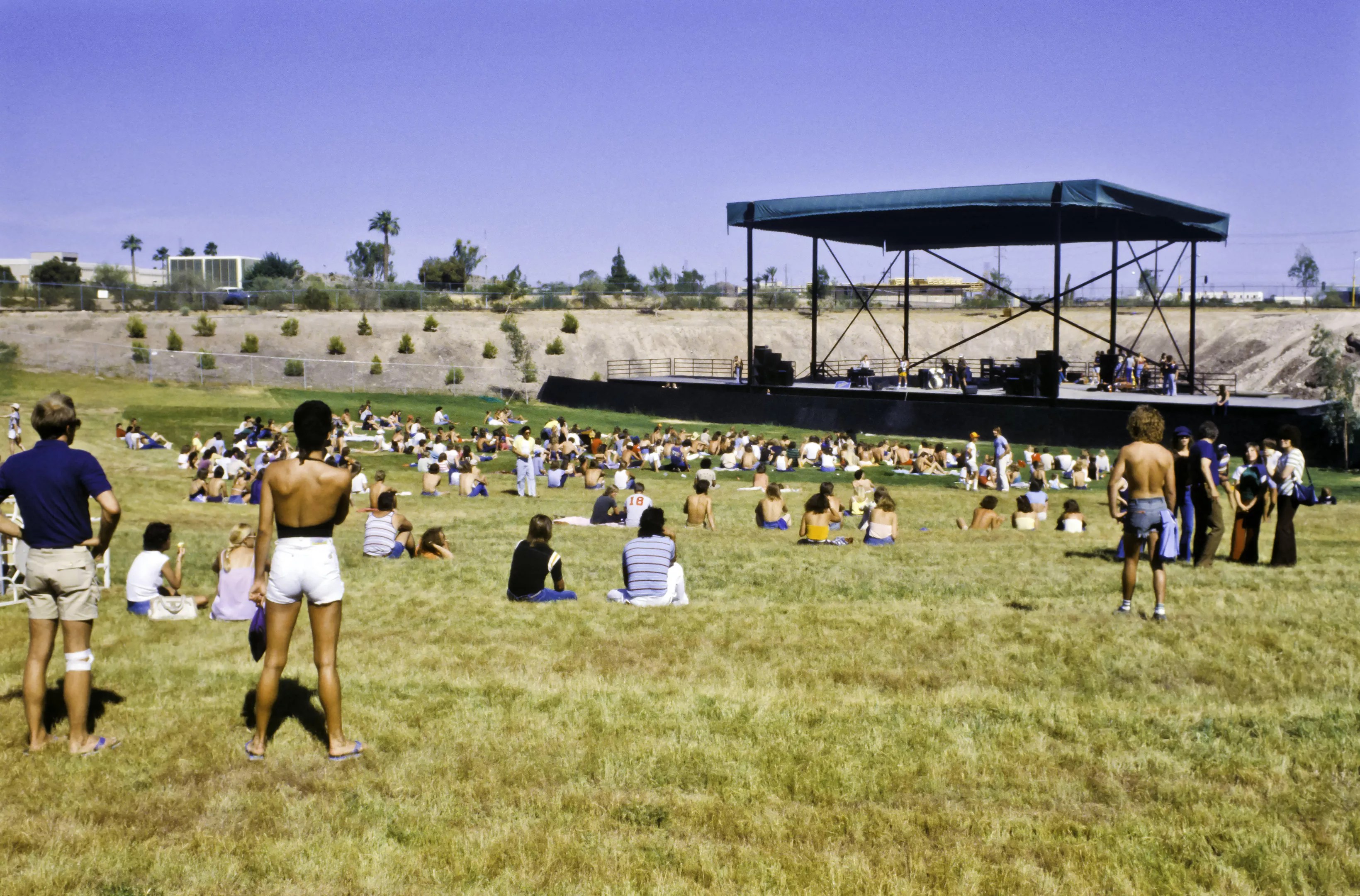
The original Compton Terrace in 1980.
Compton Terrace
5555 E. Van Buren St.
Currently: Fiftyfive55 office buildingSay the name “Compton Terrace” to old-school Valley residents and they might immediately ask back, “Which one?” There were two versions of the famed outdoor amphitheater, with the first located on the Phoenix/Tempe border inside the storied Legend City amusement park. Built by local entrepreneur Jess Nicks (father of rock ‘n’ roll queen Stevie Nicks) and his brother Gene, it occupied the southeastern corner of Legend City and debuted in July 1979. It also provided a new source of income to the struggling amusement park.
Filling a need for large-capacity concert venues in the Valley, the first Compton Terrace featured a 20,000-person capacity and an unrivaled lineup of shows. The Nicks partnered with local promoter Doug Clark and brought big-name rock and pop stars of that era to its stage, including Elton John, Dan Fogelberg, Cheap Trick, Grateful Dead and Linda Ronstadt.
Legend City finally went under in 1983, forcing Compton Terrace to relocate to what was then known as Firebird Lake in Chandler. (AC/DC performed the final show at its original home.) Concerts continued to take place there through the ’90s and 2000s until its demolition a decade ago.
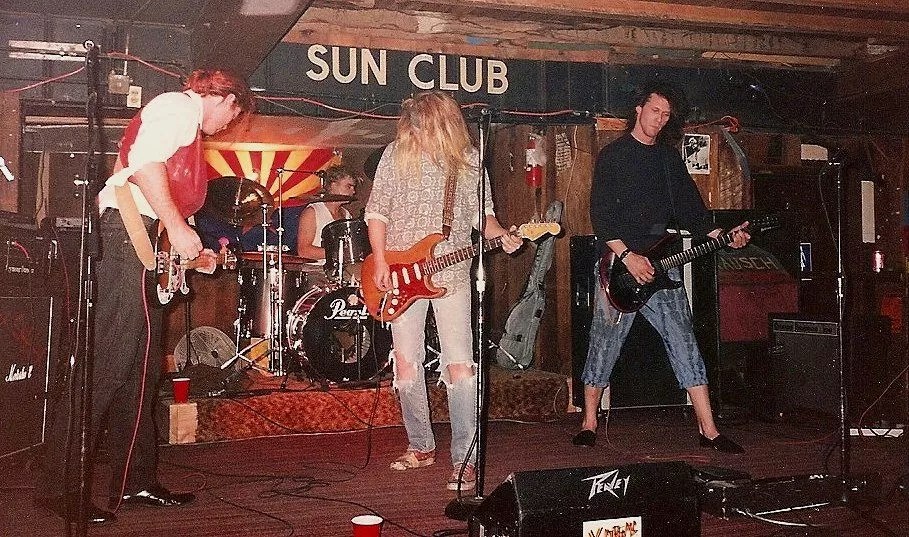
Dashboard Mary performs at The Sun Club in 1996.
Tempe History Museum
The Sun Club
1001 E. Eighth St., Tempe Valor on Eighth in Tempe. Google Maps
Currently: Valor on Eighth There will never be another place like the Sun Club. Easily one of the more legendary and seminal music venues in Tempe history, it was a breeding ground, cultural incubator and launching pad for what would become some of the city’s most illustrious rock acts.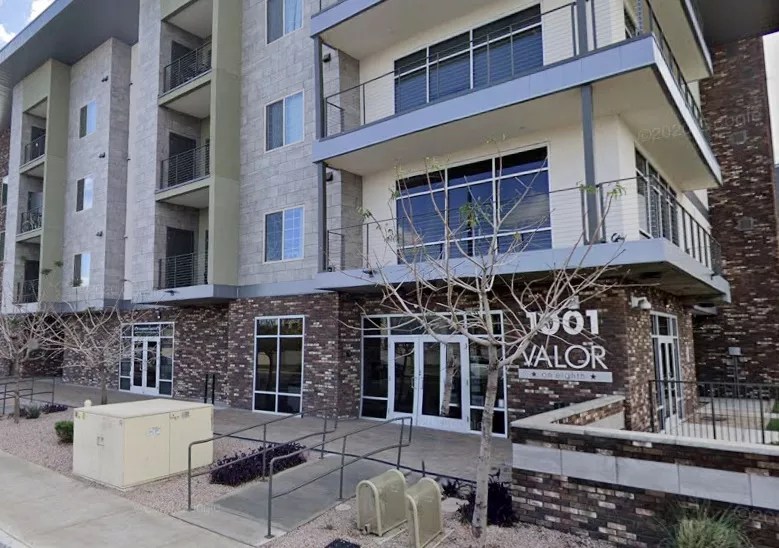
Case in point: The Gin Blossoms attracted major label interest after a memorable show here in the early ’90s. The members of Dead Hot Workshop were also regulars during the band’s formative years and would pay homage in 1995 by using a photo of the Sun Club as the cover art for their album “1001.”
Bluesman Hans Olson began a long association with the place in 1969 when it was known as The Library and offered him a regular spot to jam. He became owner in the late ’80s, fixed it up, and rechristened it with its best-known moniker while racking up $48,000 in debt, necessitating selling it off 18 months later. The Sun Club lived on for another couple of years before closing in 1992. A four-story apartment building called Valor on Eighth is now located on the property.
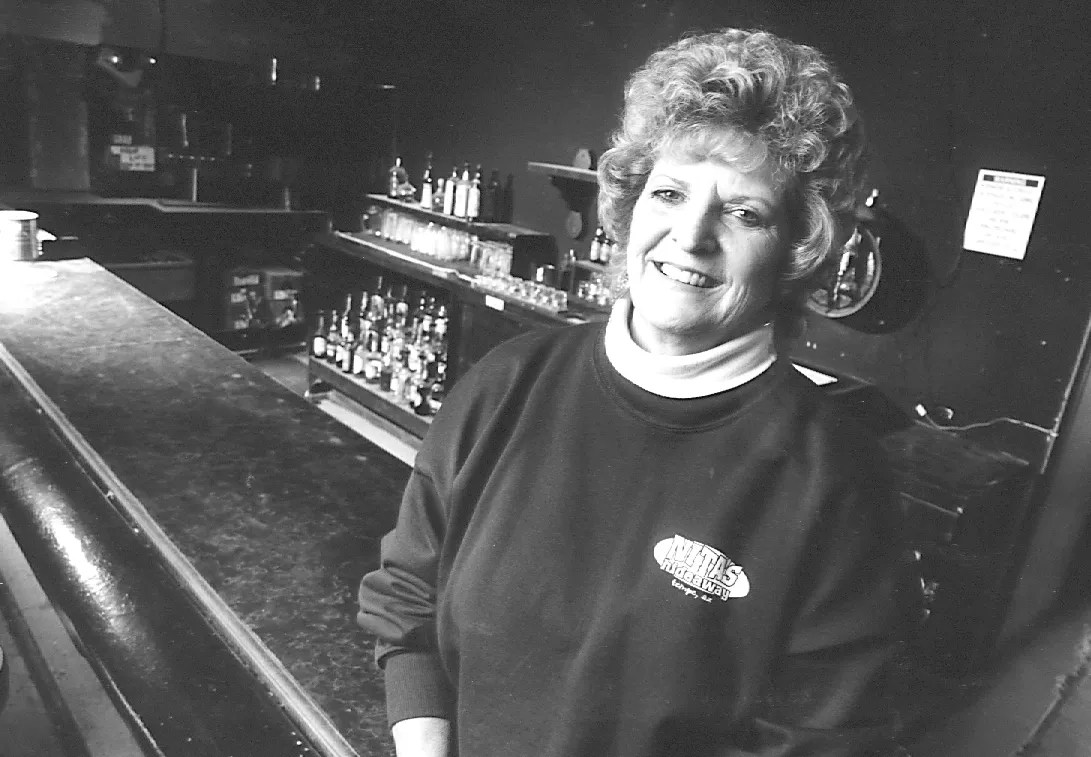
A photo of the late Nita Craddock, the original owner of Nita’s Hideaway, from 1998.
Timothy Archibald
Nita’s Hideaway
1816 E. Rio Salado Parkway, Tempe
Currently: Tempe MarketplaceIn early 1995, Nita’s Hideaway, the small out-of-the-way dive on Rio Salado Parkway owned by the late rodeo queen Nita Craddock, had a watershed moment: It hosted the first of a series of weekly sets by the now-defunct pop band the Piersons. It was the first-ever show at the bar arranged by Charlie Levy, who had to cajole its owner into allowing it to happen. Craddock finally relented, allowing her namesake spot to become etched in the annals of Tempe music lore.
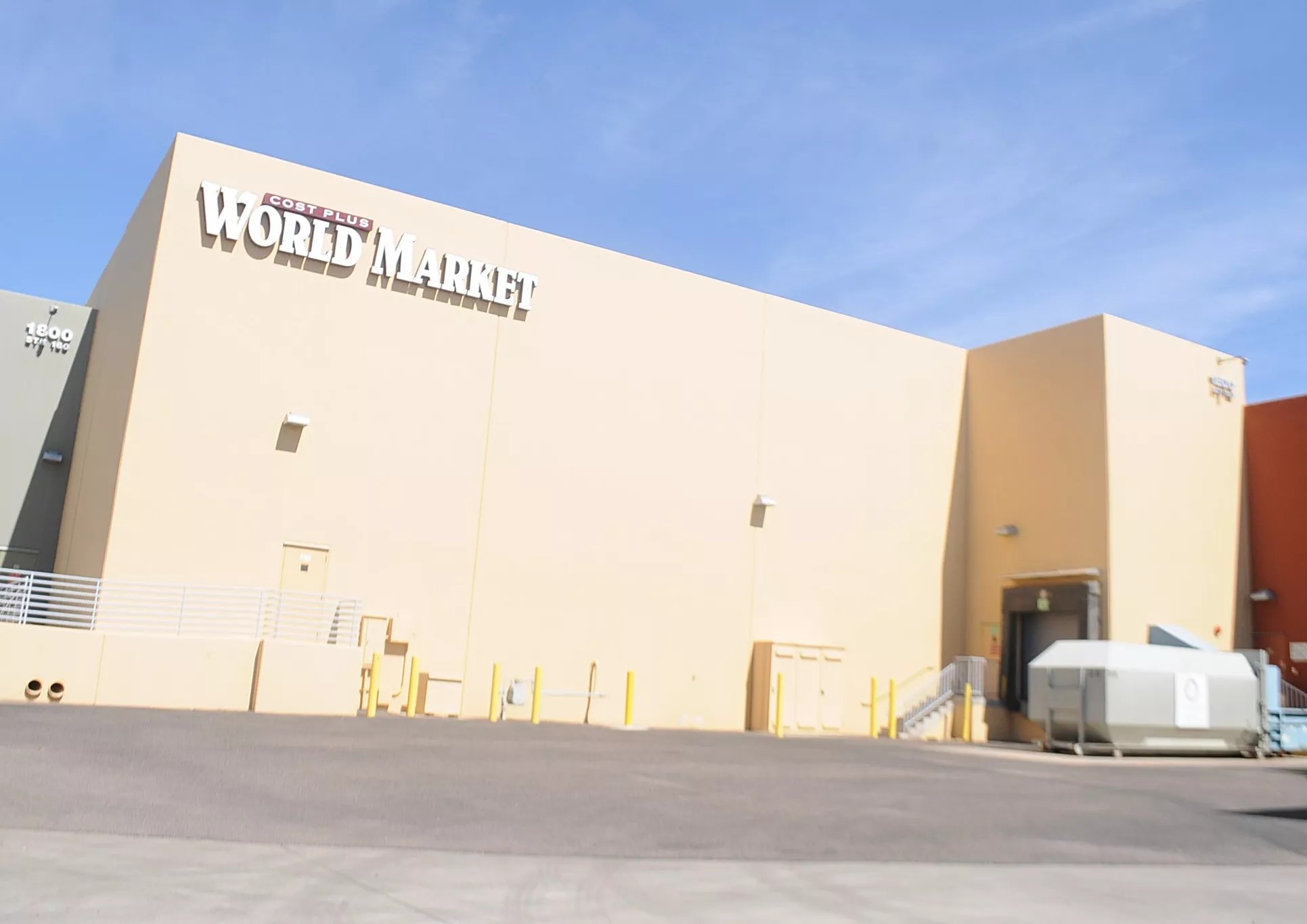
A Cost Plus World Market is now located where Nita’s once stood.
Benjamin Leatherman
The Piersons were the first of literally thousands of bands to perform at Nita’s over the next seven years, helping it become a staple of the local music circuit. Craddock allowed Levy to build a stage, buy a sound system and bring in bigger acts on weekends, like Tucson’s Giant Sand. Things quickly blew up from there as Nita’s became a hub for indie and tastemaking rock.
Then came a number of twists and turns. Craddock became fed up with the bar biz and sold the building in 1998, only to buy it back months later after its new owners’ attempt at an all-ages punk club failed. Then, the late Mark Covert purchased it in 1999 and returned Nita’s to its former glory in 2000 with Levy’s assistance. Unfortunately, the bar and other nearby businesses were earmarked for the future Tempe Marketplace and torn down in 2003 to make way for the shopping center.
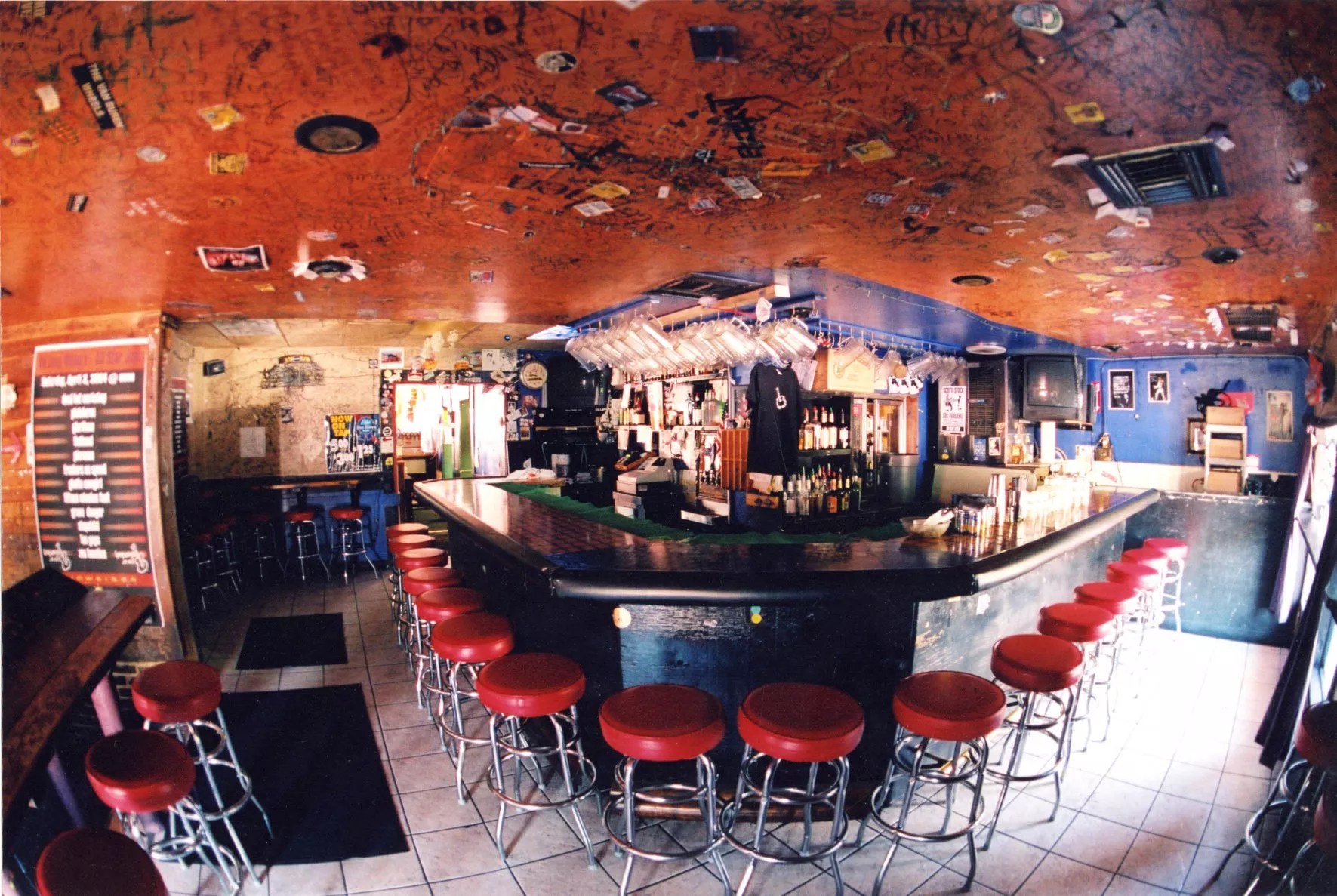
The interior of Long Wong’s on Mill Avenue in 2004.
David Rhodes/Tempe History Museum
Long Wong’s
701 S. Mill Ave., Tempe
Currently: VacantLong Wong’s on Mill was the epicenter of the Tempe scene during its glory years and the nucleus of an interconnected network of musicians, clubs and fans. An esteemed institution that hummed with live music nightly for 16 years straight, it’s where bands wanted to be seen and heard. Although the Gin Blossoms will forever be linked to the place, they weren’t the only ones that made its tiny stage their home.
The list of those who were featured at Wong’s is nearly endless: The Beat Angels. Zen Lunatics. The Pistoleros. The Refreshments. Busted Hearts. Gloritone. Revenants. Trophy Husbands. Flathead. Even the late Elvis “The Cat” Delmonte, an entertainingly eccentric artist, even got stage time. Long Wong’s ultimately was a barometer of Tempe’s music scene, rising in prominence and importance as interest in its brand of rock and pop did the same. Its closure in 2004 came as a blow and surprise to many, even after the spotlight on Mill had long since faded.
And though Long Wong’s was demolished to reportedly make way for future development along Mill, its plot has remained vacant ever since, serving as an occasional parking lot and a gaping reminder of what was.
Editor’s note: This article was previously published in October 2015 and August 2020 and has been updated. New Times thanks the Tempe History Museum and Bruce Liddil for the use of their photos.